HTC HERA PDA phone User Manual Atlas Generic English Manual indb
HTC Corporation PDA phone Atlas Generic English Manual indb
HTC >
Contents
User Manual Part 2 revsied 0207
112 Exchanging Messages
• If you are working offline, e-mail messages are moved to the Outbox
folder and will be sent the next time you connect.
To add an attachment to a message
1. In the message that you are composing, tap Menu > Insert and tap
the item you want to attach: Picture, Voice Note, or File.
2. Select the file you want to attach, or record a voice note.
View and reply to messages
To read an incoming message
By default, only the first few kilobytes of a message are shown when you
open and read an incoming message. To read the whole message, do one of
the following:
• Scroll down to the end of the message and tap Get the rest of this
message; or
• Tap Menu > Download Message.
The message will be downloaded the next time you tap Menu > Send/
Receive to send and receive e-mail.
Notes • If your company is running Microsoft Exchange Server 2007, the message
downloads immediately, without waiting until the next time you
synchronize. For more information about working with company e-mails,
see Chapter 10.
• The size column in the message list displays the local size and server size
of a message. Even when an entire message has been downloaded, these
numbers may differ because the size of a message can vary between the
server and the device.
To download an attachment
An attachment appears below the subject of the message. Tapping the
attachment opens the attachment if it has been fully downloaded or marks
it for download the next time you send and receive e-mail.
Notes • If there are multiple attachments in the message, all attachments are
downloaded.
• For information about setting your device to automatically download file
attachments, see "Customize e-mail settings".
• If your company is running Microsoft Exchange Server 2007, the
attachment downloads immediately, without waiting until the next time
Exchanging Messages 113
you synchronize. For more information about working with company
e-mails, see Chapter 10.
To reply to or forward a message
1. Open the message and tap Menu > Reply, Menu > Reply All, or
Menu > Forward.
2. Enter your response. To quickly add common messages, tap Menu >
My Text and tap a desired message.
3. To check the spelling, tap Menu > Spell Check.
4. Tap Send.
Tips • To see more header information, scroll up.
• To always include the original message, from the list view, tap Menu >
Tools > Options > Message tab, and select the When replying to e-mail,
include body check box.
• In the Outlook E-mail account, you will send less data if you do not edit
the original message. This may reduce data transfer costs based on your
rate plan.
To view and reply to HTML e-mails
You can receive, view and reply to HTML e-mails from any type of e-mail
account. The HTML format is retained, without layout shifting or resizing.
Note HTML e-mail support in Outlook Mobile is available only if your company is
using Microsoft Exchange Server 2007.
1. Set the message format to HTML. To find out how to set the message
format, see “Customize e-mail settings”.
2. Tap Start > Messaging, select your e-mail account, and open an
HTML e-mail that you received.
3. Tap the Tap to scroll right option to be able to scroll sideways and
get a complete horizontal view of the message.
4. Tap Get the rest of this message that’s shown at the bottom of the
message to download and view the whole message.
5. If the e-mail does not download immediately, tap Menu > Send/
Receive.
114 Exchanging Messages
6. If images do not immediately appear on the message, tap Internet
pictures blocked then tap Download Internet pictures.
7. Tap Menu and choose whether to reply to the sender(s) or forward
the message.
8. Enter your response then tap Send.
Tip E-mail can contain hyperlinks to web pages.
Download messages
The manner in which you download messages depends on the type of e-
mail account you have.
To send and receive e-mail for an Outlook account
1. Tap Start > Programs > ActiveSync.
2. Connect your device to your PC using the USB cable or Bluetooth.
Otherwise, connect wirelessly if you are synchronizing Outlook
e-mail with the Exchange Server. For more information, see Chapter 9.
3. Synchronization automatically begins, and your device sends and
receives Outlook e-mail.
Tip You can also manually synchronize anytime by tapping Sync in ActiveSync or
Menu > Send/Receive in Outlook Mobile.
To send and receive e-mail for a POP3/IMAP4 account
If you have an e-mail account with an ISP or a work account that you access
using a VPN server connection, you send and receive messages through a
remote e-mail server. Before sending and downloading messages, you first
need to connect to the Internet or your corporate network.
1. Tap Start > Messaging and tap your POP3 or IMAP4 e-mail account.
2. Tap Menu > Send/Receive. The messages on your device and e-mail
server are synchronized: new messages are downloaded to the device
Inbox folder, messages in the device Outbox folder are sent, and
messages that have been deleted from the server are removed from
the device Inbox folder.
Exchanging Messages 115
Customize e-mail settings
To change the download size and format for Outlook e-mail
1. Disconnect your device from the computer.
2. Tap Start > Programs > ActiveSync.
3. Tap Menu > Options, select E-mail, then tap Settings.
4. On the E-mail Sync Options screen:
• Under Download size limit, select the desired email size.
• Under Message format, select HTML or Plain text.
5. Close ActiveSync and reconnect your device to the computer.
To change the download size and format for POP3/IMAP4 e-mail
1. Tap Menu > Options on the Account Picker screen, or tap Menu >
Tools > Options while you’re in a message list.
2. Tap your e-mail account.
3. Keep tapping Next until you reach Server information.
4. Tap Options then tap Next twice.
5. Under Download size limit, select the desired email size.
6. Under Message format, select HTML or Plain text.
7. Tap Finish.
To exclude your e-mail address when replying to all
When you reply to all the recipients of an Outlook e-mail, your own e-mail
address will also be added to the recipient list. Customize ActiveSync so that
your e-mail address will be excluded from the recipient list.
1. In ActiveSync on your device, tap Menu > Options.
2. Select the E-mail information type and tap Settings.
3. Tap Advanced.
4. In the My e-mail addresses text box, enter your e-mail address.
5. Tap OK.
116 Exchanging Messages
To automatically receive attachments on Outlook e-mails
1. Tap Start > ActiveSync.
2. Tap Menu > Options.
3. Tap E-mail > Settings, then select Include file attachments.
To automatically receive attachments on IMAP4 e-mails
1. Tap Start > Messaging.
2. Tap Menu > Options.
3. Tap the name of your IMAP4 account.
4. Tap Next until you reach Server information, then tap Options.
5. Tap Next twice, then select a download size from the Download
attachments smaller than list box.
To store attachments on a storage card
1. Tap Menu > Tools > Options > Storage tab.
2. Select the Store attachments on storage card check box.

8.1 Connecting to the Internet
8.2 Internet Explorer Mobile
8.3 Using Comm Manager
8.4 Using Bluetooth
8.5 Using Wi-Fi
8.6 Using Internet Sharing
Chapter 8
Getting Connected
118 Getting Connected
8.1 Connecting to the Internet
Your device is equipped with powerful networking functions that enable
you to connect to the Internet or your company’s network through wireless
and conventional connections. You can set up your device to establish
a connection via Wi-Fi, GPRS, Dial-up, Bluetooth, Virtual Private Network
(VPN), or a Proxy connection.
Requirement To use Wi-Fi, GPRS and EDGE, you need to purchase an
Internet/Data plan from T-Mobile.
Your device has two groups of connection settings: T-Mobile Data and My
Work Network. T-Mobile Data settings are used to connect to the Internet,
while My Work Network settings can be used to connect to any private,
corporate network.
Wi-Fi
The easiest way to access the Internet is to use Wi-Fi. Use Wi-Fi to connect to
T-Mobile Hotspot, if you have this service added to your data plan, or other
available wireless networks. For more information about setting up a Wi-Fi
connection on your device, see “Using Wi-Fi” later in this chapter.
GPRS/EDGE
GPRS/EDGE is a non-voice value-added service that allows information to
be sent and received across a mobile telephone network. Use GPRS/EDGE
to connect to the Internet and to send and receive multimedia messages on
your device.
You will be billed per KB (Kilobyte) when you use GPRS/EDGE. Check with
T-Mobile to find out about GPRS/EDGE rates.
GPRS/EDGE settings are already preconfigured on your device, and your
device is ready to use T-Mobile GPRS/EDGE services. Please do not change
the settings as this may cause services to stop working.
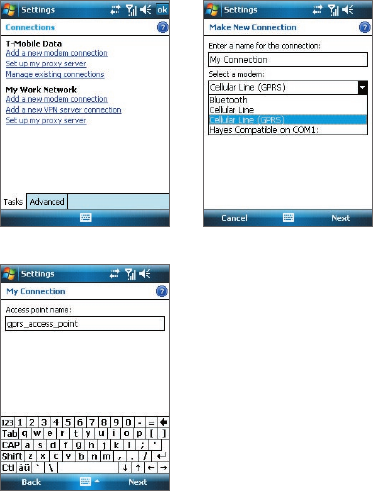
Getting Connected 119
To add a new GPRS/EDGE connection
In times when you need to add another GPRS/EDGE connection on your
device, obtain the Access point name from your wireless service provider.
Also, check if a user name and password are required.
1. Tap Start > Settings > Connections tab > Connections.
2. Under T-Mobile Data, tap Add a new modem connection.
3. On the Make New Connection screen, enter a name for the
connection.
4. In the Select a modem list, select Cellular Line (GPRS), then tap
Next.
5. Enter the Access point name, then tap Next.

120 Getting Connected
6. Enter the user name and password, only if required.
7. Tap Finish.
Notes • To view help information for any screen, tap the help icon ( ).
• To modify your connection settings, tap Manage existing connections
on the Connections screen, and complete the connection wizard.
Dial-up
When you use your device to dial up to your Internet Service Provider (ISP)
and connect to the Internet, you will be billed by the number of minutes
that you use.
To set up a dial-up connection to your ISP
To establish a dial-up connection on your device, you need the same
settings that you normally use when you dial up from your computer. This
includes the ISP server phone number, your user name and password.
1. Tap Start > Settings > Connections tab > Connections.
2. Under T-Mobile Data, tap Add a new modem connection.
3. On the Make New Connection screen, enter a name for the
connection.
4. In the Select a modem list, select Cellular Line, then tap Next.
5. Enter the ISP server phone number, then tap Next.
6. Enter your user name, password, and any other information required
by your ISP.
7. Tap Finish.
Work network connections
A Virtual Private Network (VPN) connection allows you to access your
company network through your device’s Internet connection. Whereas a
proxy connection lets you access the Internet using an existing connection
to your corporate or WAP network.
To set up work network connections
1. Obtain the following information from your network administrator:
• Server phone number
• User name

Getting Connected 121
• Password
• Domain (and other required settings, such as IP address)
2. Tap Start > Settings > Connections tab > Connections.
3. In My Work Network, follow the instructions for each type of
connection.
4. Complete the connection wizard, then tap Finish.
Start a data connection
After setting up a data connection such as GPRS/EDGE or ISP dial-up
on your device, you can now connect your device to the Internet. The
connection is started automatically when you begin using a program that
accesses the Internet such as Internet Explorer Mobile.
To manually start a data connection
If you have set up multiple types of data connections on your device, you
can manually start a connection.
1. Tap Start > Settings > Connections tab > Connections.
2. Tap Manage existing connections.
3. Tap and hold the name of the desired connection, then tap Connect.
To disconnect active data connections
• Tap the Comm Manager icon ( ) on the Today screen, then tap the
Data Connection button ( ).

122 Getting Connected
8.2 Internet Explorer Mobile
Internet Explorer Mobile is a full-featured Internet browser, optimized for
use on your device.
To start Internet Explorer Mobile
• Tap Start > Internet Explorer.
To set a Home page
1. In the address bar on top of the Internet Explorer Mobile screen, enter
the desired Web page address. Tap to open the Web page.
2. Tap Menu > Tools > Options > General tab.
3. Do one of the following:
• To use the displayed page as the Home page, tap Use Current.
• To use the default Home page, tap Use Default.
Tip To go to your Home page, tap Menu > Home.
To transfer favorites from your PC
You can transfer the favorites you have stored on your PC to your device by
synchronizing the Internet Explorer favorites on your PC with your device.
1. In ActiveSync on your PC, on the Tools menu, click Options, and
select Favorites.
2. In Internet Explorer on your PC, click Favorites > Add to Favorites
and save or move favorite links to the Mobile Favorites subfolder in
the Favorites list.
3. Connect your device to your PC. If synchronization does not start
automatically, click Sync.
To add a favorite
1. In Internet Explorer Mobile, go to the page you want to add.
2. Tap and hold the page, and tap Add to Favorites.
3. Confirm or change the name, and select a folder for storing the
favorite.
4. Tap Add.
Getting Connected 123
To delete a favorite or folder
1. In Internet Explorer Mobile, tap Menu > Favorites > Add/Delete tab.
2. Select the item you want to delete, and tap Delete.
To change the size of text on Web pages
• In Internet Explorer Mobile, tap Menu > Zoom, and tap the size you
want.
To change how Web pages fill the screen
1. In Internet Explorer Mobile, tap Menu > View.
2. Tap one of the following:
• One Column. Arranges the content into one column that is as
wide as the screen. This means that you will rarely have to scroll
horizontally.
• Default. Maintains a layout similar to what you see on a desktop
computer, but it makes items smaller and arranges the content so
that you can see most of it without having to scroll horizontally.
• Desktop. Keeps the same layout and size as on a desktop
computer, which will require both horizontal and vertical scrolling.
To clear the History list
1. In Internet Explorer Mobile, tap Menu > Tools > Options > Memory
tab.
2. Tap Clear History.
To save a picture from a Web page
1. In Internet Explorer Mobile, tap and hold the picture, and tap Save
Image.
2. Do one of the following:
• To save the picture in My Pictures on your device, tap Yes.
• To save the picture in another location, such as a storage card, tap
Save As.
124 Getting Connected
To delete temporary Internet files
Your device temporarily stores Web pages that you frequently visit or have
visited recently to speed up the display of these Web pages when you
access them. You may want to delete these files to free storage space.
1. In Internet Explorer Mobile, tap Menu > Tools > Options > Memory
tab.
2. Tap Delete Files. All pages stored on your device, including offline
favorites content, will be deleted.
To set up Internet security settings
Cookies are small files containing information about your identity and
preferences so that a page can tailor information to your needs. The page
sends the file, and it is stored on your device.
1. In Internet Explorer Mobile, tap Menu > Tools > Options > Security
tab.
2. To prevent Internet Explorer Mobile from accepting any cookies, clear
the Allow cookies check box.
3. Select the check boxes for the other security options you want, and
tap OK.
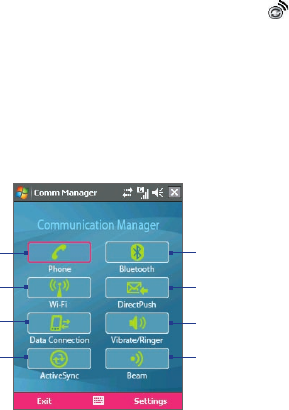
Getting Connected 125
8.3 Using Comm Manager
Comm Manager acts like a central switcher that lets you enable or disable
phone features as well as manage your data connections easily.
To open Comm Manager
• Tap the Comm Manager icon ( ) on the Today screen; or
• Press the Comm Manager button on the right side of the device.
Simply tap the corresponding button to enable or disable a feature.
1
2
3
5
6
7
4 8
1Tap to toggle between enabling or disabling
the phone. Tap Settings > Phone to set
the ring tone and other phone settings. For
more information about customizing phone
settings, see Chapter 5.
2Tap to toggle between turning on or off Wi-Fi.
Tap Settings > Wi-Fi to configure Wi-Fi on
your device. See "Using Wi-Fi" for details.
3Tap to disconnect active data connections
(e.g. GPRS/EDGE). You cannot reconnect a
data connection in Comm Manager.
4Tap to open ActiveSync so you can
synchronize the device and computer. For
more information about the configuration
settings for ActiveSync, see Chapter 4.
5Tap to toggle between turning on or off
Bluetooth. Tap Settings > Bluetooth to
configure Bluetooth on your device. See
"Using Bluetooth" for details.
6Tap to toggle between automatically
receiving (as items arrive) or manually
retrieving Outlook e-mails. For more
information, see "Schedule synchronization
with Exchange Server" in Chapter 4.
7Tap to toggle between turning on the
phone's ringer or setting the phone to
vibration/mute mode.
8Tap to toggle between enabling or disabling
your device to receive beamed information.
126 Getting Connected
8.4 Using Bluetooth
Bluetooth is a short-range wireless communications technology. Devices
with Bluetooth capabilities can exchange information within a distance
of about 10 meters without requiring a physical connection. You can even
beam information to a device in a different room, as long as it is within the
Bluetooth signal coverage range.
Bluetooth can be used in the following ways:
• Beam information, such as files, appointments, tasks, and contact
cards, between devices that have Bluetooth capabilities.
• Synchronize information between your device and computer via
Bluetooth.
• Use a Bluetooth-enabled headset (or other Bluetooth-enabled hands-
free device such as a car kit) with your device for hands-free phone
conversations.
• Use a Bluetooth service. Once you connect to another device or
computer using Bluetooth, you can locate and use any of the services
available on that device.
• Create a connection between your device and another Bluetooth-
enabled phone to use that phone as a modem.
Note Normally, you will need another phone as a modem only if your Pocket PC
device has no integrated phone capability.
Bluetooth modes
Bluetooth on your device operates in three different modes:
• On. Bluetooth is turned on. Your device can detect other Bluetooth-
enabled devices, but not vice versa.
• Off. Bluetooth is turned off. In this mode, you can neither send
nor receive information using Bluetooth. You might want to turn
Bluetooth off at times in order to conserve battery power, or in
situations where using a wireless device is prohibited, such as on
board an aircraft and in hospitals.
• Visible. Bluetooth is turned on, and all other Bluetooth-enabled
devices can detect your device.
Getting Connected 127
Note By default, Bluetooth is turned off. If you turn it on, then turn off your device,
Bluetooth also turns off. When you turn on your device again, Bluetooth
automatically turns on.
To turn Bluetooth on and make your device visible
1. On your device, tap Start > Settings > Connections tab > Bluetooth
> Mode tab.
2. Select the Turn on Bluetooth and Make this device visible to other
devices check boxes.
3. Tap OK.
Bluetooth partnerships
A Bluetooth partnership is a relationship that you create between your
device and another Bluetooth-enabled device in order to exchange
information in a secure manner. Creating a partnership between two
devices involves entering the same Bluetooth passcode on both devices.
Creating a partnership between two devices is a one-time process. Once
a partnership is created, the devices can recognize the partnership and
exchange information without entering a passcode again. Make sure that
on the two devices, Bluetooth is turned on and in visible mode.
To create a Bluetooth partnership
1. On your device, tap Start > Settings > Connections tab >
Bluetooth.
2. On the Devices tab, tap Add new device. Your device searches for
other Bluetooth devices and displays them in the box.
3. Tap the desired device name in the box.
4. Tap Next.
5. Specify a passcode to establish a secure connection. The passcode
can be 1 up to 16 characters.
6. Tap Next.
7. Wait for the paired device to accept the partnership. The receiving
party needs to enter the same passcode that you specified.
8. The name of the paired device is then displayed. You may edit and
enter a new name for that device.
9. Select the check boxes of services that you want to use from the
paired device.
10. Tap Finish.
128 Getting Connected
To accept a Bluetooth partnership
1. Ensure that Bluetooth is turned on and in visible mode.
2. Tap Yes when prompted to establish a partnership with the other
device.
3. Enter a passcode (the same passcode that is entered on the device
requesting the partnership) to establish a secure connection. The
passcode must be between 1 and 16 characters.
4. Tap Next.
5. Tap Finish. You can now exchange information with the paired
device.
To rename a Bluetooth partnership
1. Tap Start > Settings > Connections tab > Bluetooth.
2. Tap and hold the partnership on the Devices tab.
3. On the shortcut menu, tap Edit.
4. Enter a new name for the partnership.
5. Tap Save.
To delete a Bluetooth partnership
1. Tap Start > Settings > Connections tab > Bluetooth.
2. Tap and hold the partnership on the Devices tab.
3. Tap Delete.
Connect a Bluetooth hands-free or stereo headset
For hands-free phone conversations, you can use a Bluetooth hands-free
headset such as a car kit with your device.
Your device also supports A2DP (Advanced Audio Distribution Profile)
which is for stereo audio over Bluetooth. This means that you can use
a Bluetooth stereo headset with your device for hands-free phone
conversations as well as for listening to stereo music. Make sure that your
stereo headset also supports A2DP.
Just like when connecting to any Bluetooth device, you also need to enter
a passcode when connecting to a Bluetooth hands-free or stereo headset.
The passcode is fixed and cannot be changed on a Bluetooth headset.
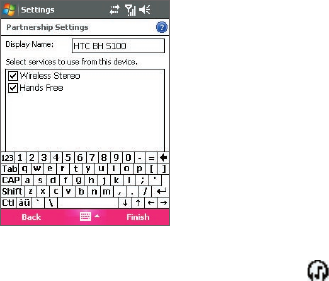
Getting Connected 129
Before you connect it to your device, check for the proper passcode in the
manufacturer’s documentation.
To connect a Bluetooth hands-free or stereo headset
1. Make sure that both your device and the Bluetooth headset are
turned on and within close range, and that the headset is visible.
Refer to the manufacturer’s documentation to find out how to set the
headset in visible mode.
2. Tap Start > Settings > Connections tab.
3. Tap Bluetooth > Devices tab > Add new device. Your device
searches for other Bluetooth-enabled devices and displays them in
the list.
4. Tap the name of the Bluetooth headset, then tap Next.
5. Enter the passcode of the Bluetooth headset, then tap Next.
6. Make sure the Hands Free check box is selected.
If you have a Bluetooth stereo headset, also make sure the Wireless
Stereo check box is selected.
7. Tap Finish.
While the Bluetooth headset is connected, the Headset icon ( ) will
appear on the title bar.
130 Getting Connected
Note If the Bluetooth stereo headset becomes disconnected, turn the headset on
and repeat steps 1 to 3 above. Tap and hold the name of the Bluetooth stereo
headset and tap Set as Wireless Stereo.
Beam information using Bluetooth
You can beam information, such as contacts, calendar items, and tasks, as
well as files from your device to your computer or to another Bluetooth-
enabled device.
Note If your computer does not have built-in Bluetooth capability, you need to
connect and use a Bluetooth adapter or dongle on your computer.
To beam information from your device to a computer
1. Turn on Bluetooth on your device, and make your device visible. For
information about this, see “To turn Bluetooth on and make your
device visible”.
2. You also need to set Bluetooth on your computer to visible mode. Do
one of the following:
• If your computer has Windows XP SP2 and your computer’s built-
in or external Bluetooth adapter is supported by Windows XP
SP2, open Bluetooth Devices from the Control Panel. Click the
Options tab, then select the Turn discovery on and the Allow
Bluetooth devices to connect to this computer options.
• If the Bluetooth adapter on your computer was installed using
a third-party provided driver, open the Bluetooth software
that came with the Bluetooth adapter. This software varies
by manufacturer, but in most cases, you will find a Bluetooth
Configuration utility which you can open from the Control Panel.
After Bluetooth Configuration opens, click the Accessibility
tab, then select Let other Bluetooth devices to discover this
computer. Refer to the Bluetooth adapter’s documentation for
more information.
3. Create a Bluetooth partnership between the two devices.
For information about creating a partnership, see “Bluetooth
partnerships”.
After a partnership has been created successfully, your computer is
ready to receive Bluetooth beams.
Getting Connected 131
4. On your device, tap and hold an item to beam. The item can be an
appointment in your calendar, a task, a contact card, or a file.
5. To beam a contact, tap Menu > Send Contact > Beam.
To beam other types of information, tap Menu > Beam [type of
item].
6. Tap the device name to which you want to send the beam.
7. If you beamed an Outlook item and it is not automatically added to
Outlook, select File > Import and Export in Outlook to import it.
To beam information to a Bluetooth-enabled device such as another Pocket
PC, follow steps 3 to 6 in the above procedure.
Note If the computer or device you want to beam to does not appear in your
device's Bluetooth list, make sure that its Bluetooth is turned on and set to
visible mode.
To receive a Bluetooth beam
Your device will not detect and notify you of incoming Bluetooth beams
unless you set it up to do this.
1. Tap Start > Settings > Connections tab > Beam.
2. Select the Receive all incoming beams check box.
3. Make sure your device is turned on, visible, and within close range of
the device that is beaming the information.
4. When prompted to receive an incoming beam, tap Yes to receive the
beamed information.
Bluetooth Explorer and Bluetooth file sharing
Bluetooth Explorer searches for other Bluetooth devices that have file
sharing enabled and lets you access their Bluetooth shared folder. You
can copy files from and to their shared folder, and create subfolders in it.
When you enable Bluetooth file sharing on your device, other Bluetooth-
enabled devices will also be able to access your Bluetooth shared folder.
To enable Bluetooth Explorer and Bluetooth file sharing on your device
1. Tap Start > Settings > Connections tab > Bluetooth > FTP tab.
2. Select the Enable Bluetooth Explorer check box. This makes the
\Bluetooth device folder visible in the File Explorer.
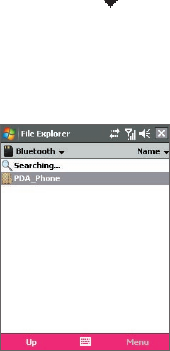
132 Getting Connected
3. Select the Enable File Sharing check box.
You can use the default Bluetooth shared folder, or tap Browse to use
another folder as your shared folder.
To use Bluetooth Explorer
1. Bluetooth Explorer is integrated with the File Explorer program. You
can open it by tapping Start > Programs > Bluetooth Explorer or
by tapping Down arrow ( ) on the upper left of File Explorer then
tapping Bluetooth.
2. Bluetooth Explorer then scans for other Bluetooth devices that have
file sharing enabled. From the list, tap to select a Bluetooth device you
want to connect to. You may need to enter a passcode in order for you
to connect to the selected device.
3. If there are files contained in the Bluetooth shared folder on the other
device, you will be able to see them on the Bluetooth Explorer screen.
Select one or more files, then tap Menu > Edit and choose to cut or
copy the files.
4. Tap Up twice.
5. Navigate to the folder where you want to paste the files on your
device, then tap Menu > Edit > Paste.
Getting Connected 133
Use the device as a Bluetooth modem
You can connect your device to a notebook or desktop computer through
Bluetooth and use the device as a modem for the computer.
Note If your computer does not have built-in Bluetooth capability, you need to
connect and use a Bluetooth adapter or dongle on your computer.
For the computer to use the Internet connection of your device, activate
Internet Sharing on your device, then set up a Bluetooth Personal Area
Network (PAN) between the computer and your device.
1. On your device, turn on Bluetooth and set it to visible mode.
2. Initiate a Bluetooth partnership from your device by following the
steps in “To create a Bluetooth partnership.“
Alternatively, you can initiate a Bluetooth partnership from the
computer by following these steps (based on Windows XP SP2):
a. In the Control Panel or System Tray, double-click the Bluetooth
Devices icon.
b. In the Bluetooth Devices window, click Add.
c. The Add Bluetooth Device Wizard opens. Select the My device is
set up and ready to be found check box, then click Next.
d. The wizard then detects your device and displays its name in the
dialog box. Select the device name, then click Next.
e. Select Let me choose my own passkey, then enter a passcode
(1 up to 16 digits) that will serve as an identification number for
establishing a secure connection between your device and the
computer. Click Next.
f. A confirmation message then appears on your device. Tap Yes to
accept the connection, enter the same passcode, then tap Next.
g. On the computer, click Finish to exit the wizard.
h. On your device’s Partnership Settings screen, you can change the
display name for the computer, then tap Finish.
3. Now, open the Internet Sharing program on your device. Tap Start >
Programs > Internet Sharing.
4. Select Bluetooth PAN as the PC Connection.
134 Getting Connected
5. From the Network Connection list, select the name of the
connection that your device uses to connect to the Internet.
6. Tap Connect.
7. On your computer, set up a Bluetooth Personal Area Network (PAN)
with your device:
a. Tap Start > Control Panel > Network Connections.
b. Under Personal Area Network, click the Bluetooth Network
Connection icon.
c. Under Network Tasks, click View Bluetooth network devices.
d. In the Bluetooth Personal Area Network Devices dialog box, select
your device, then click Connect.
8. On the Internet Sharing screen on your device, check if a connected
status is displayed, which indicates that your computer has been
successfully connected to the Internet using your device as a
Bluetooth modem.
Use another Bluetooth phone as a modem
You can use another phone that has Bluetooth as a modem for your device
to browse the Internet or to transfer other information.
To do this, create a Bluetooth modem connection on your device and then
send information to the phone by using Bluetooth. The phone relays the
information over the mobile phone network and then sends back to your
device any information that you had requested over the connection.
Once you create a modem connection to the Bluetooth phone, you can
reuse it whenever you want to use the phone as a modem. Make sure that
Bluetooth is turned on and visible mode is enabled on both your device and
the phone, and that the two are within close range.
Note Normally, you will need another phone as a modem only if your Pocket PC
device has no integrated phone capability.
To use a Bluetooth phone as a modem for your device
1. On your device, tap Start > Settings > Connections tab >
Connections.
2. Tap Add a new modem connection.
Getting Connected 135
3. Enter a name for the connection.
4. In the Select a modem list, tap Bluetooth.
5. Tap Next.
6. If the phone appears in the My Connections list, skip to step 11.
7. If the phone does not appear in the My Connections list, tap Add
new device, and follow the remaining steps.
8. Select the phone from the list and tap Next.
9. Enter a passcode and tap Next.
10. Enter the same passcode on the phone and tap Finish.
11. In the My Connections list on your device, select the phone and tap
Next.
12. Enter the phone number to dial for this connection and tap Next.
13. Enter the required logon information for this connection and tap
Finish.
8.5 Using Wi-Fi
Wi-Fi provides wireless Internet access over distances of up to 100 meters.
To use Wi-Fi on your device, you need access to a wireless access point or
“hotspot”.
T-Mobile HotSpot gives you wireless access to the Internet over the
T-Mobile Wi-Fi network in convenient locations across the U.S., such as
airports, coffeehouses, bookstores, universities, and more. It is great for e-
mail, Web browsing, and other high-bandwidth applications. Contact
T-Mobile to add T-Mobile Hotspot service to your data plan.
Note The availability and range of your device’s Wi-Fi signal depends on the
number, infrastructure, and other objects through which the signal passes.
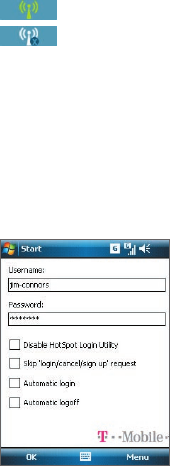
136 Getting Connected
Turn Wi-Fi on and off
1. Open the Comm Manager.
2. Tap the WLAN button to turn on/off the wireless function. The WLAN
icon indicates the wireless status.
: Wi-Fi is turned on.
: Wi-Fi is turned off.
3. Available wireless networks will be detected. For more information
about connecting to T-Mobile Hotspot or other wireless networks,
refer to the procedures below.
Connect to T-Mobile Hotspot
You can set up your device to automatically log into T-Mobile’s wireless
network whenever you connect to T-Mobile Hotspot.
1. Tap Start > Settings > Connections tab > T-Mobile Hotspot.
2. Enter your username and password.
3. Select the Automatic login checkbox.
4. If you also want to be logged off automatically when you turn off Wi-
Fi, select the Automatic logoff checkbox.
5. Tap OK.
6. Open the Comm Manager and turn on Wi-Fi.
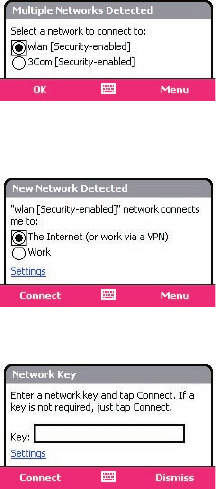
Getting Connected 137
7. Your device scans for available wireless networks and then lists them
on a pop-up message window. Select T-Mobile then tap OK.
8. Tap Connect.
Connect to other wireless networks
1. Open the Comm Manager and turn on Wi-Fi.
2. Your device then scans for available wireless networks in your
area. The network names of the detected wireless networks will be
displayed on a pop-up message window. Tap the desired wireless
LAN, then tap OK.
3. On the next pop-up message window, tap The Internet if the wireless
LAN connects your device to the Internet. Otherwise, tap Work if the
wireless LAN connects your device to a private network.
4. If the wireless LAN is secured by a network key, enter this key, then
tap Connect.
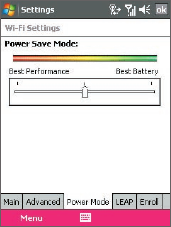
138 Getting Connected
Next time you use your device to detect wireless networks, you
will not see the pop-up message windows again, and you will not
be prompted to enter the network key of the previously accessed
wireless network (unless you perform a hard reset which will erase
custom settings on your device).
Note Wi-Fi networks are self-discoverable, which means no additional steps are
required for your device to connect to a Wi-Fi network. It may be necessary
to provide a username and password for certain closed wireless networks,
however.
Battery power saving when using Wi-Fi
Using Wi-Fi consumes battery power fast. Turn off Wi-Fi when not in use. You
can also enable power saving settings.
To save battery power while connected to a wireless network
1. Tap Start > Settings > Connections tab > Wi-Fi Status to open the
Wi-Fi Settings screen.
2. On the Power Mode tab of the Wi-Fi Settings screen, move the Power
Save Mode slider to a position that optimizes performance with the
least power consumption.
For example, move the slider to the left (Best Performance) to have
the optimal WLAN performance; move to the right (Best Battery) to
obtain the maximum battery usage.
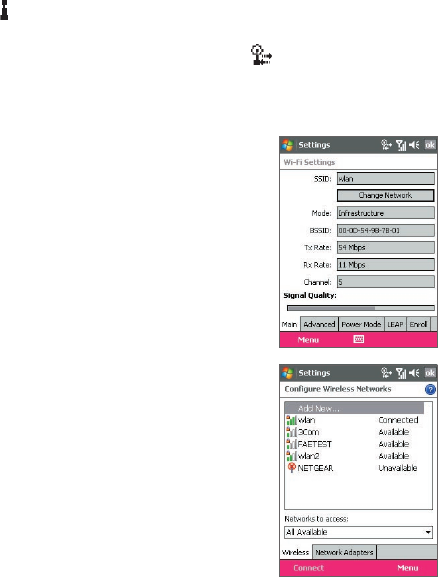
Getting Connected 139
Check wireless LAN status
You can check the current wireless connection status from the following
three screens of your device:
• Title bar. When you enable Wi-Fi on your device, the Wi-Fi ON icon
( ) will appear on the title bar of the Today screen.
After Wi-Fi is turned on, your device scans for available wireless
networks and the wireless signal icon ( ) appears on the title bar.
The arrows in this icon will move back and forth while your device
is scanning for a wireless LAN signal. Once your device successfully
connects to a wireless LAN, the arrows stop moving.
• Wi-Fi Settings screen (the Main tab).
Here, it shows the name of the wireless
network that your device is currently
connected to. The configuration and
signal quality of the wireless network
are also shown.
• Configure Wireless Networks screen.
Tap Start > Settings > Connections
tab > Wi-Fi > Wireless tab. This screen
displays the wireless networks currently
available.
To connect to a wireless network in
the list, tap and hold on the desired
network, then tap Connect.
Tap a wireless network in the list to view
or change its connection settings.
You can also add new wireless
networks, if available, by tapping Add
New.
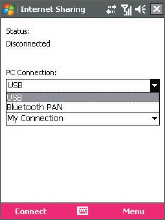
140 Getting Connected
8.6 Using Internet Sharing
Internet Sharing connects your PC or notebook computer to the Internet
by using your device’s data connection (GPRS or EDGE, for instance). You
can choose to connect via USB or Bluetooth.
Follow the procedure in this section to set up your device as a USB modem.
To learn how to set up your device as a Bluetooth modem, see “Use the
device as a Bluetooth modem” in this chapter.
Notes • Make sure your device has a SIM card installed, and you have set up
a GPRS/EDGE or phone dial-up modem connection on your device. If
your device has not been set up with a data connection yet, tap Menu
> Connection Settings on the Internet Sharing screen. For more
information about setting up a GPRS connection, see "To set up a GPRS
connection to the Internet". For more information about setting up a
phone dial-up connection, see "To set up a dial-up connection to your
ISP".
• If you want to use a USB cable connection, you must first install Microsoft
ActiveSync version 4.2 or later on the computer.
• Before using Internet Sharing, disable ActiveSync on your computer.
To set up your device as a USB modem
1. On your device, tap Start > Programs >
Internet Sharing.
2. In the PC Connection list, select USB.
3. In the Network Connection list, select
the name of the connection that your
device uses to connect to the Internet.
4. Plug in the USB cable between your
device and the computer.
5. Tap Connect.
To end the Internet connection
• On the Internet Sharing screen, tap
Disconnect.

9.1 Windows Live Mobile
9.2 Windows Live Search
9.3 Windows Live Messenger Mobile
9.4 Sending Photos to Your Windows Live Space
Chapter 9
Using Windows Live
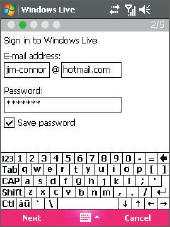
142 Using Windows Live
9.1 Windows Live Mobile
Windows Live Mobile gives you full Internet experience on your device. It
helps you to find information, pursue your interests, and get in touch with
friends and family on the Internet easier.
Windows Live Mobile offers the following key features:
• Windows Live Search, which is Windows Live’s search engine for
finding information on the web.
• Windows Live Contacts, your address book for storing Windows Live
Mail, Windows Live Messaging, and Hotmail contacts.
• Windows Live Messenger Mobile, the next generation of MSN
Messenger Mobile.
• Windows Live Mail, the next generation of Hotmail.
Set up Windows Live Mobile
The first time you use Windows Live Mobile, sign in by using your Windows
Live ID, which is your Windows Live Mail or Hotmail address, and password.
To set up Windows Live Mobile for the first time
1. Tap Start > Programs > Windows Live.
2. Tap Sign in to Windows Live.
3. On the next screen, tap the links to
read the Windows Live Term of Use and
the Microsoft Privacy Statement. After
reviewing them, tap Accept.
4. Enter your Windows Live Mail or Hotmail
address and password, select the Save
password checkbox, then tap Next.
5. Choose whether or not to show
Windows Live’s search bar and
applications on the Today screen then
tap Next.
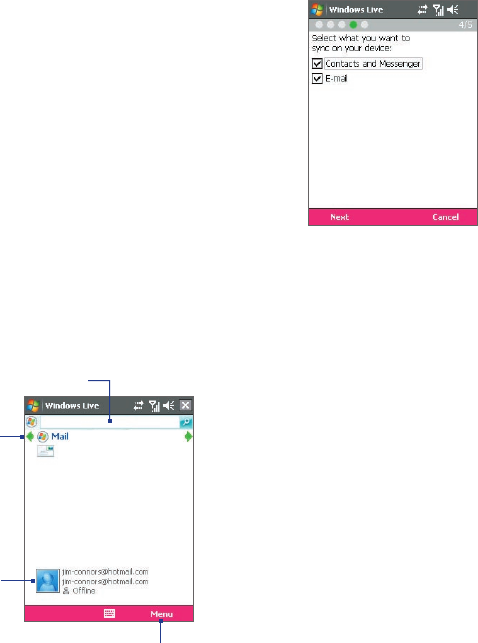
Using Windows Live 143
6. Choose what information you want to
synchronize online with your device.
If you choose to synchronize Contacts
and Messenger, your online contacts
will be added to the contact list and to
Windows Live Messenger Mobile on
your device.
If you choose to synchronize E-mail,
your Windows Live Mail or Hotmail
inbox messages will be downloaded to
your device.
7. Tap Next.
8. After synchronization is complete, tap
Done.
The Windows Live Mobile interface
On the main interface of Windows Live Mobile, you will see a search bar,
navigation bar, and an area where you can customize to show your picture.
1This is Windows Live Search.
See "Windows Live Search" in this
chapter for details.
2Tap the Left or Right arrow to switch
among Live Mail, Messenger, and
Sync status.
3Tap to access Windows Live
Messenger. See"Windows Live
Messenger" in this chapter for
details.
4Tap Menu to access and change
settings.
1
2
3
4
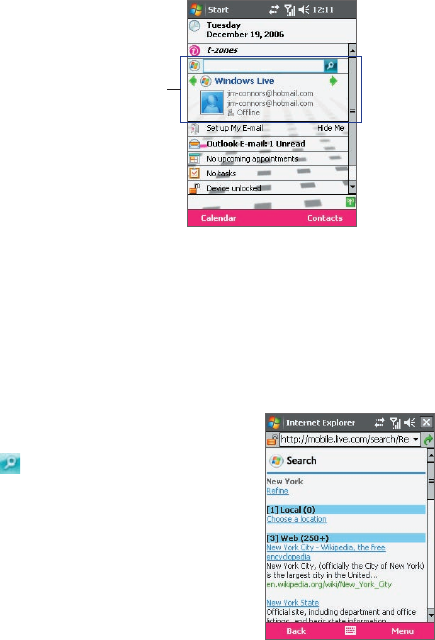
144 Using Windows Live
If you chose to display the search bar and Windows Live applications on the
Today screen when you were setting up Windows Live, you’ll see them on
the Today screen:
Search bar and
Windows Live applications
To show or hide them, open Windows Live and tap Menu > Options >
Today screen content.
9.2 Windows Live Search
Windows Live Search allows you to easily find information on the Internet.
It is integrated in the Windows Live Mobile interface, and appears as a
search bar.
To find information on the Internet
1. Enter your keywords in the search bar.
2. Tap or Search.
Internet Explorer Mobile then launches
and displays links to related web sites.
The links are organized in categories.
• Local. Allows you to perform a local
search when you’re trying to locate
a certain place or street address. See
“To search for a location” for details.
Search results
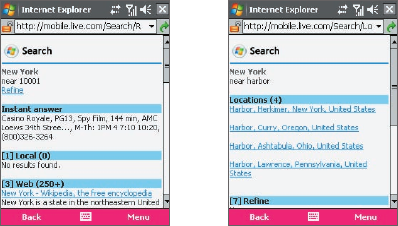
Using Windows Live 145
• Web. Shows the results from the web search, which are links to all
related web sites.
• Map. Shows links to web sites containing maps.
• News. Shows related links to news articles.
• Spaces. Shows related links to interests, photos, and all kinds of
information that are shared in Windows Live Spaces.
3. Scroll through the categories and tap a link to go to the web site
where the information that you want is located.
To search for a location
After entering your keywords in the search bar, do the following:
1. On the Internet Explorer Mobile screen, tap Choose a location under
the Local category.
2. In the Near box, enter the zip or postal code, city, or state where the
place you’re looking for is located. You may also enter a specific street
name or a general location name as your search keyword.
3. Tap Search.
4. If an exact match is found, it will be displayed under Instant answer.
Otherwise, possible locations will be listed under Local. Tap a link to
view more information about a location.
Example 1: An exact match Example 2: Location candidates
146 Using Windows Live
9.3 Windows Live Messenger Mobile
Windows Live Messenger Mobile allows you to send and receive instant
messages online. With this mobile version of Windows Live Messenger,
you enjoy many of the same cool features that you get from the desktop
version, which include the following:
• Instant messaging via text and voice
• Multiple conversations
• Add emoticons
• Contact list with presence
• Send and receive files including photos
• Change status/display name
• View contacts by online status, groups, and more
• Send messages even when a contact is offline
Note Before you can use Windows Live Messenger Mobile, your device must be
connected to the Internet. For information about setting up an Internet
connection, see “Connecting to the Internet” in Chapter 6.
Launch the messenger and sign in
To open Windows Live Messenger Mobile
Do one of the following:
• Tap Start > Programs > Windows Live Messenger Mobile.
• On Windows Live or the Today screen, tap the Left or Right arrow until
you see Messenger, then tap it.
To sign in and out
1. To sign in, tap Sign in on the messenger screen.
2. If this is your first time to sign in, a message appears to inform you
that your messenger contacts will be added to the contact list on your
device. Tap OK to add them.
Signing in may take several minutes, depending on your connection
speed.
3. To sign out, tap Menu > Sign Out. Your status changes to Offline.
Using Windows Live 147
Add Windows Live contacts
You can add new Windows Live contacts in the messenger or in Contacts.
To add a Windows Live contact in the messenger
1. Tap Menu > Add new contact.
2. Enter the e-mail address of the contact then tap OK.
To add a Windows Live contact in Contacts
1. Tap Start > Contacts.
2. Tap New then tap Windows Live.
3. In the IM box, enter the e-mail address of the contact, which can be a
Windows Live ID or any other e-mail address.
Tip You can fill in other information about the contact, if desired. This is
not absolutely necessary if you will communicate with the contact only
through Windows Live Messenger or Live Mail.
4. Tap OK.
5. Follow the remaining instructions to add the new contact to your
Windows Live contact list.
To delete a contact
1. In the messenger, select the contact and tap Menu > Contact
options > Remove contact.
2. Choose whether to block the contact.
3. Choose whether to also delete the contact from your device’s contact
list.
4. Tap OK.
Send instant messages
You can send instant messages with emoticons, and even talk by sending
a voice clip. While chatting, you can send and receive files directly on a
message window. You can also start conversations with several contacts
and switch between their message screens, or you can invite participants to
join in a conversation.
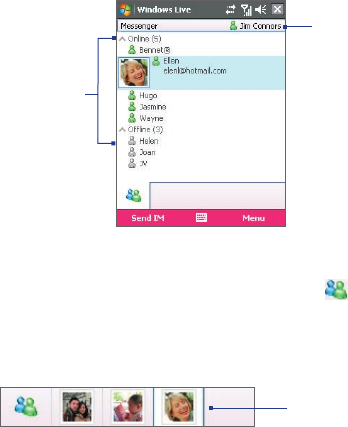
148 Using Windows Live
To start and end conversations
1. In the contact list, select a contact then tap Send IM to open a
message screen.
Your display name
Windows Live
contacts
2. Send an instant message. See “To send an instant message with
emoticon” for details.
3. To start a conversation with another contact, tap to go back to
the contact list, then select another contact and tap Send IM again.
Another message screen opens.
4. To switch from one message screen to another, tap the display picture
of the contact whom you want to talk to.
Pictures of contacts whom
you’re talking to
5. To end a conversation with the current contact, tap Menu > End
conversation.
6. To end all active conversations, tap Menu > End all conversations.
To send an instant message with emoticon
1. Select a contact and start a conversation.
2. Enter your text message in the text entry area of the message screen.
3. To add an emoticon, tap Menu > Add emoticon then tap an icon
from the list of emoticons.
4. Tap Send.
Using Windows Live 149
Tips • To send a file, tap Menu > Send. You can choose to send a picture, voice
clip or any file.
• To invite one or more contacts to the conversation, tap Menu > Options >
Add participant.
To talk using your voice
1. Select a contact and start a conversation.
2. xxx
3. xxx
4. xxx
Personalize the messenger
While on the contacts list, you can do the following:
• Tap Menu > Change status to set your current status (such as Busy,
Out to lunch, etc.) so that your contacts will know whether or not
you’re available.
• Tap Menu > Change appearance to change your display name, add a
personal message, and add your picture.
• Tap Menu > Sort by to organize contacts by online status, groups,
name, or e-mail address. You can also hide offline contacts from the
contact list.
• Tap Options to see more settings.
9.4 Sending Photos to Your Windows Live Space
If you created your own live space, you can send upload pictures to Spaces.
To upload pictures to your Windows Live Space
1. Tap Start > Programs > Pictures & Videos.
2. Select a picture then tap Send to your space.
150 Using Windows Live

Chapter 10
Using Outlook with
Exchange Server
10.1 Synchronizing Your Device with the
Exchange Server
10.2 Working With Company E-mails
10.3 Managing Meeting Requests
10.4 Finding Contacts in the Company Directory
10.5 E-mail Security

152 Using Outlook with Exchange Server
10.1 Synchronizing Your Device with the
Exchange Server
If you want to keep up-to-date with your company e-mails and meeting
schedules while you’re out of the office, you can connect your device to the
Internet wirelessly and synchronize these information with your company’s
Exchange Server. You can also access your company addressbook anytime.
Your company must have a mail server that is running Microsoft Exchange
Server with Exchange ActiveSync.
Get the Exchange Server settings
Before you can start to synchronize or access information from the
Exchange Server, you need to know the Exchange Server name and domain
name of your company’s mail server. You can get these information from
your network administrator, or do the following steps to find them in your
office computer:
1. In Outlook, click Tools > E-mail Accounts.
2. Select View or change existing e-mail accounts.
3. Double-click Microsoft Exchange Server.
4. On the Exchange Server Settings screen, you will see the Exchange
Server name.
5. To check the domain name, click Start > Settings > Control Panel,
then double-click System.
6. In the System Properties dialog box, click the Computer Name tab.
You will then see the domain name.
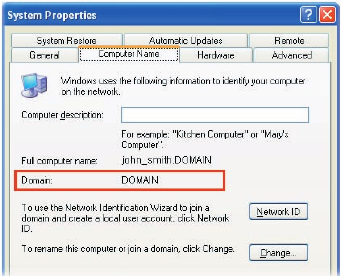
Using Outlook with Exchange Server 153
Set up an Exchange Server connection
To set up an Exchange Server connection on your device, enter the
Exchange Server name, domain name, and the user name and password
that you use at work onto your device.
If you have not synchronized your device with your PC, follow these steps to
set up an Exchange Server connection.
1. Tap Start > Messaging > Outlook E-mail
2. Tap New E-mail Account on the Account Picker screen.
3. Select Other in the Your e-mail source list, then tap Next.
4. Select Outlook E-mail in the Your e-mail provider list, then tap
Next.
5. In Server address, enter the Exchange Server name, and tap Next.
6. Enter your user name, password, and domain, and tap Next.
Tip To change the rules for resolving synchronization conflicts, tap
Advanced.
7. Select the check boxes for the types of information items that you
want to synchronize with the Exchange Server.
154 Using Outlook with Exchange Server
8. To change synchronization settings of an information type, for
example, E-mail, select the type of information, and tap Settings.
9. Tap Finish.
Note If you synchronized e-mails with your PC before, open ActiveSync on
your device and tap Menu > Add Server Source to set up an Exchange
Server connection. When you're prompted to select information types for
synchronization, you need to clear the E-mail check box under the Windows
PC item first before you can select the E-mail check box under Exchange
Server.
Tips To change Exchange Server settings, you can do one of the following:
• On the Account Picker screen, tap Menu > Options > Outlook E-mail.
• While in a message list, tap Menu > Tools > Options > Outlook E-mail.
• In ActiveSync, tap Menu > Configure Server.
To change the information types to be synchronized with the Exchange
Server, follow the same steps in changing information types to synchronize
with the PC in Chapter 5.
Start synchronization
Before you start synchronizing with the Exchange Server, make sure your
device has been set up with a data connection to the Internet so that you
can synchronize wirelessly. See Chapter 8 for details.
After you finish setting up an Exchange Server connection, your device
automatically starts synchronization.
You can manually start synchronization anytime by tapping Sync in
ActiveSync.
Note If you connect your device to your office computer via a USB or Bluetooth
connection, you can use this connection to the PC to “pass through” to the
network and download Outlook e-mails and other information to your
device.
Using Outlook with Exchange Server 155
10.2 Working With Company E-mails
Your device gives you instant access to your company e-mails and lets you
manage your messages easier. You can use some or all of the following
mobile messaging features, depending on the version of the Exchange
Server that your company is using. Please check this with your network
administrator.
• Get instant e-mails on your device using Direct Push, or set a
schedule for synchronizing Outlook.
• Use the Fetch Mail feature to download only one e-mail message at a
time without having to wait for a full synchronization.
• Remotely search for an e-mail message that is stored on the Exchange
Server.
• Filter messages that are downloaded to your device.
• Flag Outlook e-mail messages that you created on your device.
• Automatically reply messages with an “out-of-office” status.
• Open links to SharePoint documents.
• Receive, reply to, forward, and compose IRM-protected e-mail.
• Encrypt and digitally sign messages. (See “E-mail Security” for details).
Automatic synchronization through Direct Push
Direct Push technology (push e-mail feature) enables you to receive new
e-mails on your device as soon as they arrive in your Inbox on the Exchange
Server. With this feature, items such as contacts, calendar and tasks are
also immediately updated onto your device when these items have been
changed or new entries have been added on the Exchange Server. To make
Direct Push work, you need to have a GPRS connection on your device.
You need to perform a full synchronization between your device and the
Exchange Server first before Direct Push can be enabled.
Requirement The Direct Push feature works for your device only if your
company is using Microsoft Exchange Server 2003
Service Pack 2 (SP2) with Exchange ActiveSync or
higher version.
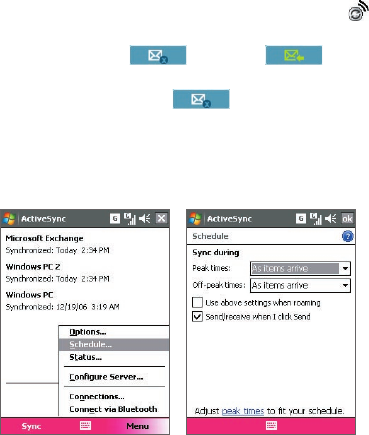
156 Using Outlook with Exchange Server
To enable Direct Push via Comm Manager
1. On the Today screen, tap the Comm Manager icon ( ).
2. On the Comm Manager screen, tap the Microsoft Direct Push
button. The button will turn to , which indicates that
you will receive e-mails as they arrive.
When the button is in the state, you need to manually
retrieve your e-mails.
To enable Direct Push via ActiveSync
1. In ActiveSync on your device, tap Menu > Schedule.
2. Select As items arrive in the Peak times and Off-peak times boxes.
Note When both the GPRS and Wi-Fi connections are turned on at the same time,
the Direct Push feature will always opt for GPRS, for which you could be
charged per your network operator’s service plan.
Using Outlook with Exchange Server 157
Scheduled synchronization
If you do not want to use Direct Push, you can set a regular schedule
for synchronizing Outlook e-mail and information. Set how often to
synchronize during Peak times (which usually refer to your working hours)
when e-mail volume is high, as well as Off-peak times when e-mail volume
is low.
1. In ActiveSync on your device, tap Menu > Schedule.
2. Select a shorter time interval in the Peak times box for you to be able
to receive e-mails more frequently.
3. Select a longer interval in the Off-peak times box.
Tip To set the days and hours that make up your peak and off-peak times, tap
Adjust peak times to fit your schedule.
Instant download through Fetch Mail
The Fetch Mail feature downloads an entire e-mail immediately without the
need for you to perform a full Send/Receive action. This limits the download
to just the e-mail message that you want and helps save data cost.
Requirement Fetch Mail works for your device only if your company is
using Microsoft Exchange Server 2007 or higher.
1. Tap Start > Messaging > Outlook E-mail.
2. Tap an e-mail message to open it.
3. By default, only the first 2KB of the message is shown. To download
the whole e-mail, scroll to the bottom of the message then tap Get
the rest of this message.
4. A “Downloading message” status appears. Wait for the remainder of
the message body to be downloaded.
Tip For information about changing e-mail sync options such as the initial
download size limit for e-mail, see "Customize e-mail settings" in Chapter 7.
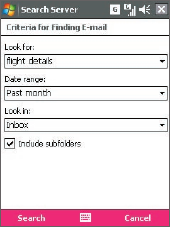
158 Using Outlook with Exchange Server
Search for e-mails on the Exchange Server
You can access messages that are not available on your device by searching
your Microsoft Exchange Server mailbox. The search results will be
downloaded and displayed in a Search Results folder.
Requirement Your company must be using Microsoft Exchange Server
2007 or higher.
1. Tap Start > Messaging > Outlook
E-mail.
2. Tap Menu > Tools > Search Server.
3. In the Look for text box, enter the
search keyword.
4. Choose the date range of messages
to search from.
5. From the Look in list, choose
whether to search from your inbox or
outbox only or to search all folders.
6. Tap Search.
Filter the message list
< how ? >
Flag your messages
Flags serve as a reminder to yourself to follow-up on important issues or
requests that are indicated in the messages. Flagging messages, which
has been a useful feature on desktop Outlook E-mail, can also be done in
Outlook Mobile on your device. You can flag received messages on your
device.
Requirement Flags are enabled only if e-mails are synchronized with
Microsoft Exchange Server 2007 or higher. Flags are
disabled or hidden if e-mails are synchronized with earlier
versions of Microsoft Exchange Server.
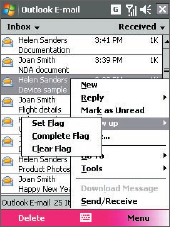
Using Outlook with Exchange Server 159
To flag or unflag a message
1. Tap Start > Messaging > Outlook E-mail.
2. Select a message, or open a message.
3. Tap Menu > Follow Up and select one of the following options:
• Set Flag Mark the message with a red flag to indicate that it needs
follow up.
• Complete Flag Mark the message with a check mark to indicate
that the issue or request in the e-mail is already completed.
• Clear Flag Remove the flag to unmark the message.
Note E-mail message reminders are displayed on your device if the messages are
flagged with reminders and synchronized from the Exchange Server
Out-of-office auto-reply
Outlook Mobile allows you to retrieve and change your out-of-office status.
Just like desktop Outlook E-mail, Outlook Mobile automatically sends an
auto-reply message when you’re not available.
To send out-of-office auto-reply messages
1. Tap Start > Messaging > Outlook E-mail.
2. Tap Menu > Tools > Out of Office.
3. From the I am currently list, select Out of the Office.
4. Enter your auto-reply message then tap Done.
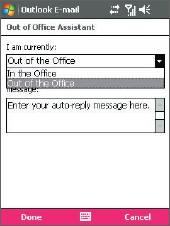
160 Using Outlook with Exchange Server
View SharePoint documents
When you receive an HTML e-mail containing a link to a SharePoint
document such as a PDF, Word, Excel, or PowerPoint file, you can tap the link
to access and view the document on your device.
Requirement Your company must be using Microsoft Exchange Server
2007 or higher.
10.3 Managing Meeting Requests
When you schedule and send meeting requests from your device, you can
invite attendees to your meeting and check their status to know about their
availability.
When you receive a meeting request, you can reply by accepting or
declining the request. The meeting request also clearly indicates whether or
not there are conflicting or adjacent meetings.
Requirement Your company must be using Microsoft Exchange Server
2007 or higher.
To check the status of invited attendees
1. Tap Start > Calendar.
2. Follow the procedure in “To send a meeting request” in Chapter 6 to
invite required and optional attendees and send a meeting request.
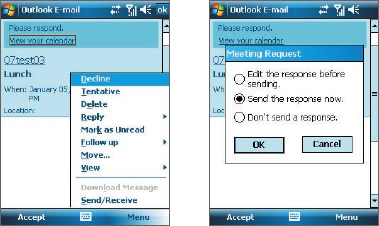
Using Outlook with Exchange Server 161
3. Wait for the attendees to respond. When their responses are sent back
to you, your calendar is updated as well.
4. To check the status of the attendees who responded, ???????? ???? ????
?????????
To reply to a meeting request
1. When there’s an incoming e-mail with a meeting request, a
notification message will be displayed on your device. Tap View to
open the e-mail.
2. Tap Accept to reply and accept the meeting request, or tap Menu >
Decline if you cannot attend the meeting.
Tips • Before responding, you can check your availability during the time
of the requested meeting by tapping View your calendar.
• If the time of the meeting conflicts with your other appointments,
a “Scheduling Conflict” status appears on top of the e-mail.
3. Choose whether or not to edit the response e-mail before sending
then tap OK:
4. If you accepted the meeting request, it will automatically be added as
an appointment in Calendar on your device.
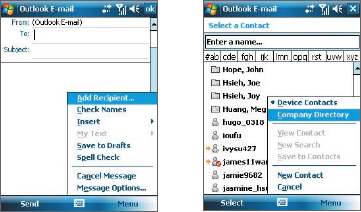
162 Using Outlook with Exchange Server
10.4 Finding Contacts in the Company Directory
In addition to having contacts on your device, you can access contact
information from your organization’s Company Directory. By having wireless
access to the Company Directory, you can easily send meeting requests and
other messages to anyone in your company.
Requirement Access to the Company Directory is available only if
your organization is running Microsoft Exchange Server
2003 SP2 or higher, and you have completed your first
synchronization with the Exchange Server.
1. Synchronize with Exchange Server if you have never done so.
2. Do any of the following:
• In Contacts, tap Menu > Company Directory.
• In a new message, tap the To box. Tap Menu > Add Recipient
then tap Company Directory.
• In a new meeting request using Calendar, tap Attendees and then
tap Company Directory at the top of the list.
3. Enter the part or full contact name and tap Search. In the search
results list, tap a contact to select it.
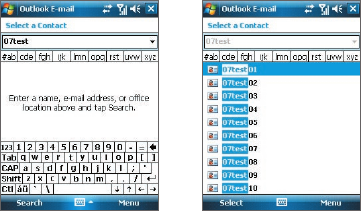
Using Outlook with Exchange Server 163
Notes • Your device must be set up with a data connection.
• You can search on the following information as long as that information is
included in your organization’s Company Directory: First name, Last name,
E-mail name, Display name, E-mail address, or Office location.
10.5 E-mail Security
Windows Mobile on your device protects your Outlook e-mails through
Secure/Multipurpose Internet Mail Extension (S/MIME), which allows you to
digitally sign and encrypt your messages.
Digitally signing a message applies your certificate with the authorization
key to the message. This proves to the recipient that the message is from
you and not from an imposter or a hacker, and that the message has not
been altered.
Encryption protects the privacy of your message by converting it from
plain, readable text into cipher (scrambled) text. Only the recipient who has
the authorization key can decipher the message.
Requirement S/MIME encryption and digital signatures for Windows
Mobile-based devices are available only with Exchange
Server 2003 SP2 or a later version that supports S/MIME. If
you are not using one of these products, or have not yet
synchronized, these options are unavailable.
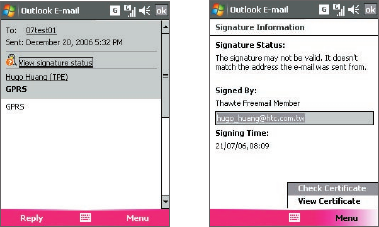
164 Using Outlook with Exchange Server
Note You can encrypt a message with or without a certificate. However, to read an
encrypted message, you need a valid certificate to decrypt it.
To individually sign and encrypt a new message
1. Tap Start > Messaging > Outlook E-mail.
2. Tap Menu > New to create a new message.
3. Tap Menu > Message Options.
4. From the Security list, select whether to encrypt only, sign the
message only, or do both.
5. Tap OK.
To verify the digital signature on a signed message you receive
1. Open the Outlook e-mail message that has been digitally signed.
2. At the top of the message, tap View Signature Status.
3. Tap Menu > Check Certificate.
To view the details of the certificate in the message, tap Menu > View
Certificate.
Note There can be several reasons why a digital signature is not valid. For example,
the sender’s certificate may have expired, it may have been revoked by the
certificate authority, or the server that verifies the certificate is unavailable.
Contact the sender to report the problem.
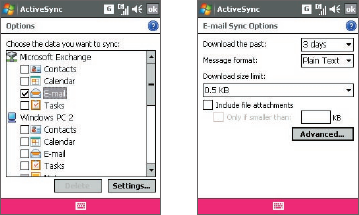
Using Outlook with Exchange Server 165
To digitally sign and encrypt all messages
You can set up ActiveSync to digitally sign and encrypt all outgoing
messages. You must obtain a valid certificate to sign and encrypt e-mail
messages successfully.
1. Tap Start > Programs > ActiveSync.
2. Tap Menu > Options.
3. Select the E-mail information type, and tap Settings. On the E-mail
Sync Options screen, tap Advanced.
4. Do one or both of the following:
• To sign all your outgoing e-mail messages so that recipients can
be certain that the messages were sent by you and have not been
altered in any way, select the Sign all outgoing e-mail messages
check box.
• To encrypt all your outgoing e-mail messages so that the
contents of your messages are protected from being viewed by
anyone other than the intended recipients, select the Encrypt all
outgoing e-mail messages check box.
5. Tap Choose Certificate to select a certificate for signing or
encrypting outgoing e-mail messages.
166 Using Outlook with Exchange Server
Set permissions on an e-mail message
Another way of protecting your e-mail messages is to send messages with
restricted permissons using Information Rights Management (IRM).
Requirement This works only with a Microsoft Outlook e-mail account
and if your company is using RMS Server SP1.
1. Tap Start > Messaging > Outlook E-mail.
2. Create a message, then tap Menu > Message Options.
3. In Permissions, do one of the following:
• To allow anyone to read the message, select Unrestricted access.
• To prevent the message from being forwarded, printed, or copied,
select Do not forward.
4. Tap OK.
Tip An IRM-protected message received on your device can only be replied to or
forwarded if the message permits it.

Chapter 11
Experiencing Multimedia
11.1 Using Camera
11.2 Using Pictures & Videos
11.3 Using Windows Media Player Mobile
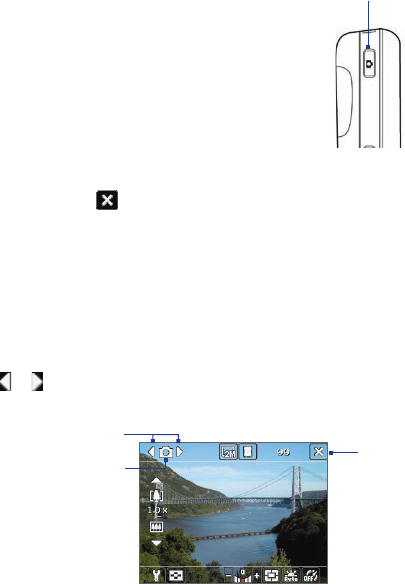
168 Experiencing Multimedia
11.1 Using Camera
Taking photos and recording video clips along with audio are easy with
your device’s built-in camera.
To open the Camera screen
• Press the CAMERA button on your device; or
• Tap Start > Programs > Camera; or
•
Tap Start > Programs > Pictures & Videos
> Camera icon.
CAMERA button
To exit the Camera
• Tap the Exit icon ( ) on the Camera screen.
Capture modes
The camera on your device allows you to capture pictures and video clips
by using various built-in modes with flexibility. The Camera is set to the
Photo capture mode by default. The upper left corner of the screen displays
the active capture mode. To switch to other capture modes, do any of the
following:
• Tap or on the Camera screen.
• Press NAVIGATION left or right.
Current capture mode.
Exit icon
Select the capture mode.

Experiencing Multimedia 169
The available capture modes of the camera are as follows:
• Photo: Captures standard still images.
• Video: Captures video clips, with or without accompanying audio.
• MMS Video: Captures video clips suitable for sending via MMS.
• Contacts Picture: Captures a still image and gives you the option to
immediately assign it as a Photo ID for a contact.
• Picture Theme: Captures still images and places them within frames.
• Sports: Captures a sequence of still images (3, 5, 7, or 10)
automatically.
• Burst: Captures a sequence of still images (maximum 30) as long
as the CAMERA button on the device or the ENTER button on the
NAVIGATION Control is kept pressed.
File formats supported
Using the above capture modes, the camera in your device captures files in
the following formats:
Capture type Format
Still image JPEG
Video MPEG-4 (.mp4), Motion-JPEG (.avi), H.263 (.3gp)
MMS Video H.263 baseline (.3gp), MPEG-4 (.mp4)
Sports / Burst
JPEG
Camera controls
Use the following device buttons and on-screen controls to take photos or
video clips and to modify settings.
The CAMERA and ENTER buttons
Press the CAMERA button on the device to open the Camera screen. If
already on the Camera screen, you can use either the CAMERA button or the
ENTER button as the shutter release.
• Press the CAMERA button or the ENTER button to take a photo or
contacts picture.
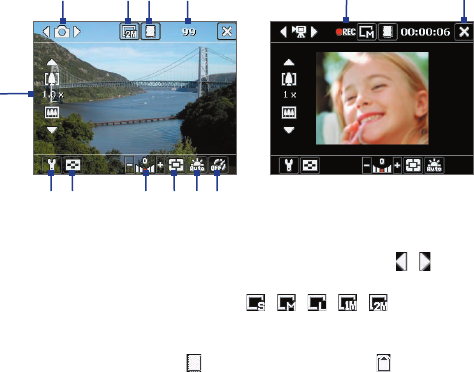
170 Experiencing Multimedia
• Press the CAMERA button or the ENTER button to start recording
video; press it again to stop recording.
• Press the CAMERA button or the ENTER button each time when taking
photos for a picture theme.
• To take consecutive shots in Sports mode, press the CAMERA button
or the ENTER button shortly, then move your device to follow the
movement of your subject.
• Press and hold the CAMERA button or the ENTER button when taking
consecutive shots in Burst mode.
The NAVIGATION Control
• Press NAVIGATION up or down to increase or decrease the zoom level.
• Press NAVIGATION left or right to go to the previous or next
sequential capture mode.
On-screen controls and indicators
5
12
6 7 8 9 10 11
1 2 3 4 13
Photo mode
Video mode
1 Mode Switching control. Tapping the left/right arrow ( / ) on the
screen allows you to switch the capture mode.
2 Resolution. The resolution icon ( / / / / ) indicates the
current resolution. Tap to toggle among the different resolutions.
3 Storage. Tap to toggle between saving captured photos or video clips
on the device memory ( ) or on the memory card ( ).
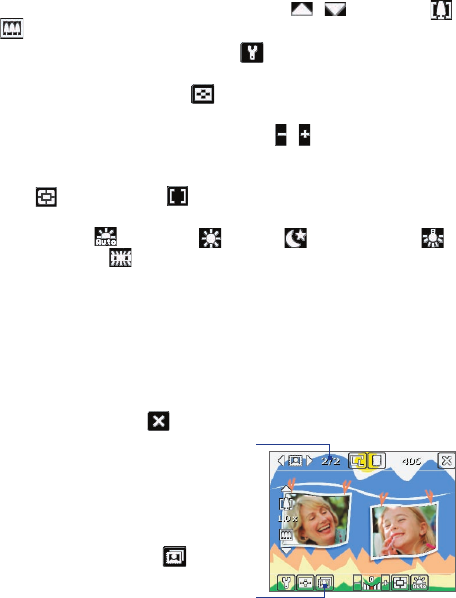
Experiencing Multimedia 171
4 Remaining information indicator. In Photo, Contacts Picture, Picture
Theme, Sports, and Burst modes, this shows the remaining, available
shots of pictures based on current settings. In Video and MMS Video
modes, this shows the remaining duration that can be recorded. While
recording video, this shows the recorded duration.
5 Zoom control. Tapping the up/down arrow ( / ) or tapping
/ on the screen allows you to zoom in or zoom out.
6 Camera Settings. Tap the Tool icon ( ) to open the Camera
Settings screen.
7 Viewer. Tap the Viewer icon ( ) to open the Pictures & Videos
screen.
8 Brightness. Tapping the minus/plus icon ( / ) decreases or
increases the brightness level.
9 Metering Mode. Tap to toggle the metering mode between Center
Area ( ) and Average ( ).
10 White Balance. Tap to toggle among the different white balance
settings: Auto ( ), Daylight ( ), Night ( ), Incandescent ( ),
and Fluorescent ( ).
11 Self-timer. Tap to set the Self-timer to 2 seconds, 10 seconds, or off
when in the Photo or Contacts Picture mode. When you press the
ENTER button or the CAMERA button to capture a still image, it starts
to count down, and then captures a still image after the assigned time
(2 seconds or 10 seconds).
12 Recording indicator. This shows a red, blinking indicator while video
recording is in progress.
13 Exit. Tap the Exit icon ( ) to exit the Camera program.
14
Progress indicator. In Picture
Theme, Sports, and Burst modes,
this shows the total number of
consecutive shots.
15
Template Selector icon. In
Picture Theme mode, tap
to toggle among the different
templates.
Picture Theme mode
14
15

172 Experiencing Multimedia
Still image capture modes
While using Still Image capture modes, such as Photo, Contacts Picture,
Picture Theme, Sports, and Burst, you can capture still image(s) by
pressing the CAMERA button on the device or the ENTER button on the
NAVIGATION. Still images will be saved in JPEG format.
While capturing an image in the Picture Theme capture mode, you can
select a preset template. To view and select from different templates, tap
on the Camera screen. Depending on the chosen template, one or more
photos may need to be taken for the template.
Video capture mode
While using the Video capture mode, you can press the CAMERA button or
the ENTER button to start recording a video clip (with audio if desired). To
stop recording, press the CAMERA button or the ENTER button again. Your
device displays the first frame of the captured video clip by default on the
Review screen.
Before you capture a video clip, you can specify the desired length of
recording in terms of time or file size on the Camera Settings screen.
Video clips can be saved in MPEG-4 (.mp4), H.263 (.3gp), or Motion-JPEG
(.avi) format.
MMS Video capture mode
The MMS Video capture mode makes it convenient for you to capture a
video file and then send it via MMS. Press the ENTER button or the CAMERA
button to start recording a video clip (with audio if desired). To stop
recording, press the ENTER button or the CAMERA button again.
The recording length of MMS video is fixed. Recording automatically
stops when the preset length is reached. However, you can manually stop
recording the video anytime. The time indicator at the upper right side of
the Camera screen indicates the time limit.
You can specify the capture format to be either H.263 or MPEG-4 on the
Camera Settings screen; however, the ideal format for MMS is H.263 (3GPP).
After you capture the video file, tap on the Review screen to send the
file through MMS.
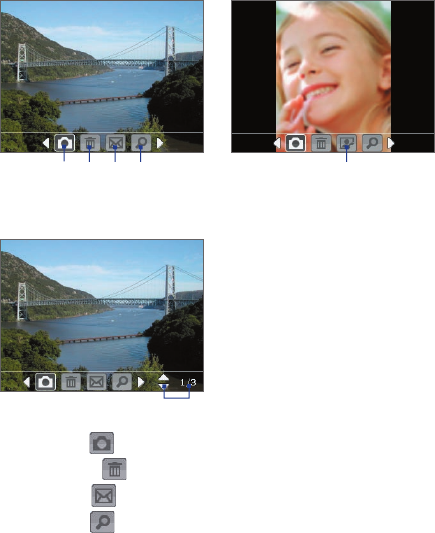
Experiencing Multimedia 173
The Review screen
After taking a still image or recording a video clip, you can view the image
or video clip on the Review screen. In addition, you can tap the icons at the
bottom of the Review screen to delete a captured image or video, send it
via e-mail or MMS, and more.
Review screen icons
5
Contacts Picture modePhoto, Video, MMS Video
and Picture Theme modes
1 2 3 4
Sports and Burst modes 6
1 Back. Tap to go back to the Camera screen.
2 Delete. Tap to remove the captured image or video.
3 Send. Tap to send via e-mail or MMS.
4 View. Tap to view the image in the Pictures & Videos program, or
play the captured video in Windows Media Player Mobile.

174 Experiencing Multimedia
5 Assign to Contacts. Tap to associate the photo to a selected
contact.
6 Browse. After you have taken photos in Sports or Burst mode,
the total number of consecutive shots is shown in the lower right
corner of the Review screen. Tap the up/down arrow ( ) or press
NAVIGATION up/down to browse through the sequence of photos.
To change the display duration of the Review screen
1. Tap to open the Camera Settings screen.
2. On the Camera Settings screen, tap . The Advanced menu then
appears.
3. Tap Review Duration, then tap the desired time length for displaying
captures on the Review screen.
Zooming
While capturing a still image or a video clip by using the camera, you can
zoom in to make the object in focus move closer, and you can zoom out to
make the object move farther away. In all capture modes, use NAVIGATION
on your device, or tap the triangular Up arrow above the Zoom Ratio
indicator, to zoom in your subject. When the zooming limit is reached, you
will hear a beep. To zoom out, press NAVIGATION down, or tap the Down
arrow. The camera zoom range for a picture or a video clip depends on the
capture mode and capture size.
Zoom range
The camera zoom range for a picture or a video clip depends on the capture
mode and capture size. The following table is a summary.
Capture mode Capture size setting Zoom range
Photo
2M (1600 x 1200) No zooming available
1M (1280 x 960) 1.0x to 2.0x
Large (640 x 480) 1.0x to 2.0x
Medium (320 x 240) 1.0x to 4.0x
Small (160 x 120) 1.0x to 10.0x

Experiencing Multimedia 175
Capture mode Capture size setting Zoom range
Video Medium (176 x 144) 1x and 2x
Small (128 x 96) 1x and 2x
MMS Video Medium (176 x 144) 1x and 2x
Small (128 x 96) 1x and 2x
Contacts
Picture
Large (480 x 640) 1.0x to 2.0x
Medium (240 x 320) 1.0x to 4.0x
Small (120 x 160) 1.0x to 4.0x
Picture Theme Determined by the current
template
Depends on the size of the
template currently loaded
Sports
Large (640 x 480) 1x and 2x
Medium (320 x 240) 1x, 2x and 4x
Small (160 x 120) 1x, 2x, 4x and 8x
Burst
Large (640 x 480) 1x and 2x
Medium (320 x 240) 1x, 2x and 4x
Small (160 x 120) 1x, 2x, 4x and 8x
Note The capture sizes available for certain capture formats also vary from
one capture mode to another. The zoom range has been calculated
based on the following ratio:
The Camera Settings screen
Camera Settings screen in Photo mode
While capturing a still image or video clip
using any capture modes, tap the Tool
icon ( ) to access the Camera Settings
screen. The Camera Settings screen
allows you to configure capture settings.

176 Experiencing Multimedia
When you tap the icons at the bottom of the Camera Settings screen,
different menus will appear. Some menus and options may be available
only in certain capture modes.
Tip You can also press the Navigation Control buttons to navigate menus.
For more information about the different menus and settings, see the
succeeding sections.
Self-timer menu
• Self-timer. Select the Self-timer option for capturing images: Off,
2 seconds, or 10 seconds. Selecting 2 seconds or 10 seconds
delays the capturing by the specified time after you press the
CAMERA button or the ENTER button.
Template menu
• Template. Select a template (in Picture Theme mode only).
Sports/Burst Settings menu
• Capture Speed. This determines the interval between shots. Fast
captures consecutive shots at the shortest interval.
• Snapshots. Select the number of consecutive shots to capture (in
Sports mode only).
Storage menu
• Storage. Select where you want to save your files. You can either
save the files to the main memory or to a storage card.
Ambience menu
• White Balance. Select a white balance setting type such as
Fluorescent, Night, etc. to suit your lighting environment.
• Effect. Choose a special effect such as Grayscale, Sepia, etc., to
apply to your photos or video clips.
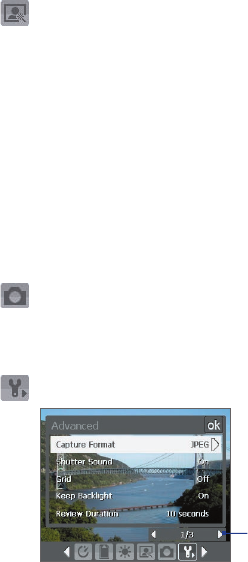
Experiencing Multimedia 177
Capture Settings menu
• Resolution. Select the desired image or video size.
• Quality. Select the JPEG image quality level for all captured still
images. You can choose from Basic, Normal, Fine, and Super
Fine.
• Metering Mode. Select a metering mode to allow the camera to
measure the amount of light in the center and around the image
and calculate the best-fit exposure value before capturing. Choose
either Center Area to measure light using the center area of the
image or Average to measure light using the area all around the
image.
• Time Stamp (Photo, Sports and Burst modes). Choose whether or
not to include the shooting date and time on captured photos.
Capture Mode menu
• Mode. Switch between different capture modes such as Photo,
Video, Contacts Picture, and more. For more information about
these modes, see “Capture modes” earlier in this chapter.
Advanced menu
Tap the left/right icon in this bar to switch
between the menu pages in the Advanced
menu.
Alternatively, when using the NAVIGATION
Control buttons, press NAVIGATION
up/down to highlight this bar. Then, press
NAVIGATION left/right to switch between
the menu pages.
• Capture Format. Select the desired file format.
• Shutter Sound. Choose whether or not you want the camera to make
a shutter sound when you press the ENTER button or the CAMERA
button to take photos or record video clips.
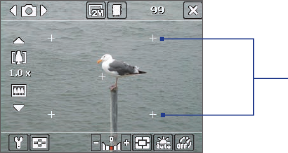
178 Experiencing Multimedia
• Grid (Photo mode only). Choose whether or not to show a grid on
the Camera screen. Showing a grid helps you frame and center your
subject more easily and accurately.
Grid
• Keep Backlight. Choose whether to turn the backlight on or off while
using the camera. This overrides your device backlight settings while
you are using the camera.
• Review Duration. Set a time length for displaying the captured
image/video on the Review screen before automatically saving it and
returning to the live Camera screen. Select No Limit if you do not
want to impose a time limit. Select No Review to immediately return
to the live Camera screen after capturing.
• Flicker Adjustment. When taking indoor shots, flicker on the camera
screen may be caused by inconsistencies between the vertical scan
rate of the camera display and the flicker frequency of fluorescent
lighting. To reduce flicker, you can change the flicker adjustment
setting to Auto or to the proper frequency (50Hz or 60Hz) of the
country where your device is being used.
• Record with Audio. Select On to record audio with the captured
video clips. This is selected by default. If you select Off and then
capture a video clip, it will have no audio.
• Prefix. Specify how to name captured images and video clips. When
Default is selected, the file name of each new captured file is set to
“IMAGE” or “VIDEO” followed by a sequential number, for example:
IMAGE_001.jpg. You may also choose to name files using either the
current Date or Date & Time as the prefix.
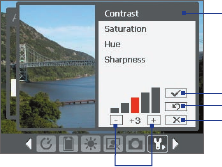
Experiencing Multimedia 179
• Counter. By default, the newly captured image or video files are
named with a prefix and some sequential numbers, such as 001, 002,
and so on. To reset the numbering to “001” for your captured files, tap
Reset.
• Recording Limit. Specify the maximum time or file size for recording.
• Template Folder (in Picture Theme mode only). By default, templates
are stored in the \My Documents\Templates folder on the device’s
Main Memory. If you transferred some templates to a storage card
(via File Explorer), set this option to Main + Card to specify that
templates are located in both the main memory and the storage card.
• Adjust. This option allows you to adjust the camera display
properties, such as Contrast, Saturation, Hue, and Sharpness.
2
3
4
1
5
1In the submenu, tap one of the properties to adjust.
Alternatively, press NAVIGATION up/down to select a property.
2To increase/decrease the value, tap the plus/minus icon or press
NAVIGATION left/right. The live Camera screen on the background
immediately displays the effect of changes.
3Tap to save the settings and close the submenu.
4Tap to reset all properties to their default.
5Tap to close the submenu without applying and saving the changes.

180 Experiencing Multimedia
11.2 Using Pictures & Videos
The Pictures & Videos program collects, organizes, and sorts images and
video clips in the following formats on your device.
File Type File Extensions
Image *.bmp, *.jpg, *.gif
GIF animation *.gif
Video *.avi, *.wmv, *.mp4, *.3gp
You can view the pictures as a slide show, beam them, send them via e-mail,
edit them, or set them as the background on the Today screen.
To copy pictures, GIF animation files, and video clips to your device
You can copy pictures, GIF animation files, and video files from your PC and
view them on your device.
• Copy the pictures, GIF animation files, and video files from your PC or
a storage card to the My Pictures folder on your device. (You can also
copy video files to the My Videos folder.)
For more information about copying files from your PC to your device, see
ActiveSync Help on your PC.
Note You can also copy pictures, GIF animation files, and video files from your
PC to your device using a memory card. Insert the memory card into the
memory card slot on your device, then copy the files from your PC to the
folder you created on the memory card.
To view pictures
1. Tap Start > Programs > Pictures & Videos. The images in the My
Pictures folder appear as thumbnails by default.
2. Select a picture and tap View. If you cannot find a picture in the
default My Pictures folder, go to another folder by tapping the Down
arrow ( ).
To play GIF animation files
1. Tap Start > Programs > Pictures & Videos.
2. Select a GIF animation file (marked with a icon)and tap View. The
GIF Animation program then opens and plays the animation.
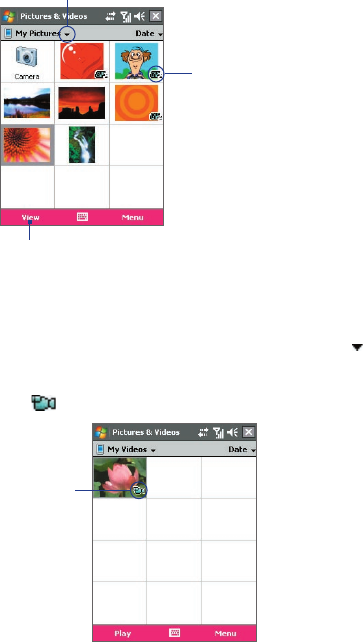
Experiencing Multimedia 181
The down arrow
Tap to view the selected image.
GIF animation icon
To play videos with audio
1. Tap Start > Programs > Pictures & Videos. By default, the contents
of the My Pictures folder will be shown.
2. To find the video clips that you captured, tap the down arrow ( )
next to the My Pictures folder and tap My Documents > My Videos.
Video clips are displayed as thumbnails by default, which appear with
a media icon ( ).
The media icon
3. Tap to select a video and play it in Windows Media Player Mobile.
182 Experiencing Multimedia
To view slide shows
You can view your pictures as a slide show on your device. Pictures are
shown in full-screen view with 5-second intervals between slides.
1. Tap Start > Programs > Pictures & Videos.
2. Tap Menu > Play Slide Show.
Note You can specify how pictures are scaled to optimize their display in a slide
show. Tap Menu > Options, then tap Portrait pictures or Landscape
pictures on the Slide Show tab.
Tap anywhere on the screen to display the Slide Show toolbar, which you
can use to stop or pause the slide show, rotate the view, and more.
To sort pictures and video clips
If you store a large number of pictures or video clips on your device, you
may find it helpful to sort them to quickly find a specific picture or clip. You
can sort by name, date, and size.
1. Tap Start > Programs > Pictures & Videos.
2. Tap the sort list (labeled Date by default), and select the item you
want to sort by (Name, Date, or Size).
To delete a picture or video clip
Do any of the following to remove a picture or a video clip:
• Select a picture or video clip on the Pictures & Videos screen, and tap
Menu > Delete.
• Tap and hold the thumbnail of the picture you want to delete, then
tap Delete.
Tap Yes to confirm the deletion.
To edit a picture
You can rotate, crop, and adjust the brightness and color contrast of your
pictures.
1. Tap Start > Programs > Pictures & Videos.
2. Tap the picture you want to edit.
3. Tap Menu > Edit, and do any of the following:
• To rotate a picture 90 degrees clockwise, tap Rotate.
Experiencing Multimedia 183
• To crop a picture, tap Menu > Crop. Next, tap and drag to select
the area to crop. Tap inside the box to crop, or tap outside the box
to cancel cropping.
• To adjust the brightness and contrast levels of a picture, tap Menu
> Auto Correct.
Note To undo an edit, tap Menu > Undo. To cancel all unsaved edits you made to
the picture, tap Revert to Saved.
To set a picture as the Today screen background
You can use a picture as the background on the Today screen.
1. Tap Start > Programs > Pictures & Videos.
2. Select the picture you want to set as the background.
3. Tap Menu > Set as Today Background.
4. In Transparency level, select a higher percentage for a more
transparent picture, or a lower percentage for a more opaque picture.
5. Tap OK.
To send pictures and video clips via e-mail
You can send pictures and video clips to other devices via e-mail.
1. First, set up Messaging to send and receive messages.
2. From the program, select the item you want to send.
3. Tap Menu > Send, and select one account (such as Outlook
E-mail or MMS) to send the attached item.
4. A new message is created with the item attached.
5. Enter the recipient name and subject, and tap Send. The message will
be sent the next time you synchronize your device.
Note Pictures and video clips are saved automatically before they are sent.
To assign pictures to contacts
You can assign a picture to a contact so that you can easily identify the
contact at any point of time.
1. Tap Start > Programs > Pictures & Videos.
2. Select the picture you want to assign to a contact.

184 Experiencing Multimedia
3. Tap Menu > Save to Contact.
4. Tap the contact, or navigate and tap Select to choose the contact
from your Contacts list.
To customize more image settings
1. Tap Start > Programs > Pictures & Videos.
2. Select the picture for which you want to configure further settings.
3. Tap Menu > Options. The Options screen appears, allowing you to:
• Resize a picture so that it can be sent faster through e-mail.
• Set the direction of rotation for the Rotate function.
• Configure the view settings during slide shows and activate
screensaver options.
11.3 Using Windows Media Player Mobile
You can use Microsoft Windows Media Player 10 Mobile for Pocket PC to
play digital audio and video files that are stored on your device or on a
network, such as on a Web site.
Using Windows Media Player Mobile, you can play both audio and video
files. These are the following file formats that are supported by this version
of Windows Media Player Mobile.
Video File Formats Supported File Extensions
• Windows Media Video
• MPEG4 Simple Profile
• H.263
• Motion JPEG
• 3GPP2
.wmv, .asf
.mp4
.3gp
.avi
.3g2
Audio File Formats Supported Video File Formats Supported
• Windows Media Audio
• MP3
• MIDI
• AMR Narrow Band
• AMR Wide Band
• AAC
• 3GPP2
.wma
.mp3
.mid, .midi, .rmi
.amr
.awb
.m4a
.gcp
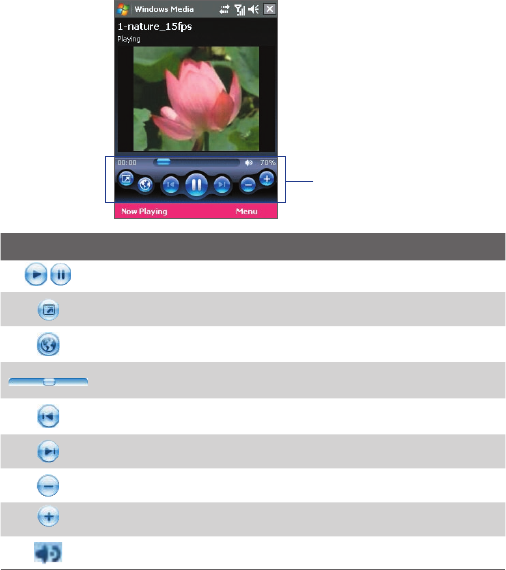
Experiencing Multimedia 185
About the controls
The following are available controls on the Windows Media Player Mobile.
Controls on Windows
Media Player Mobile
This control Does this
Play/Pause a file.
Display the video in full screen.
Display a Web site where you can find music and videos to play.
Adjust the playback progress of a selected file.
Skip to the beginning of the current file or to the previous file.
Skip to the next file.
Decrease the volume level.
Increase the volume level.
Turn the sound on or off.
186 Experiencing Multimedia
About the screens and menus
Windows Media Player Mobile has three primary screens:
• Playback screen. The default screen that displays the playback
controls (such as Play, Pause, Next, Previous, and Volume) and the
video window. You can change the appearance of this screen by
choosing a different skin.
• Now Playing screen. The screen that displays the Now Playing
playlist. This special playlist indicates the current file being played and
any files that are “queued up” to play next.
• Library screen. The screen that lets you quickly find your audio files,
video files, and playlists. It contains categories such as My Music, My
Videos, My TV, and My Playlists.
At the bottom of each screen, you can open a Menu. The commands on
this menu vary, depending upon which screen you are viewing. For more
information about the commands in these menus, see Help on your device.
About licenses and protected files
Some content (such as digital media files downloaded from the Internet,
CD tracks, and videos) have associated licenses that protect them from
being unlawfully distributed or shared. Licenses are created and managed
by using digital rights management (DRM), which is the technology for
securing content and managing its access rights. Some licenses may
prevent you from playing files that have been copied to your device. Files
that have licenses associated with them are called “protected files.”
If you want to copy a protected file from your PC to your device, use the
desktop Player to synchronize the file to your device (instead of dragging
the file from a folder on your PC to a folder on your device, for example).
This will ensure that the license is copied along with the protected file. For
more information about synchronizing files to your device and other mobile
devices, see desktop Player Help.
Note You can view the protection status for a file by checking its file properties
(tapping Menu > Properties).
Experiencing Multimedia 187
Copy media files to your device
Use the latest version of the desktop Player (Windows Media Player 10 or
later) to synchronize digital media files to your device (instead of dragging a
file from a folder on your PC to a folder on your device, for example). Using
the desktop Player ensures that licenses are copied with protected files.
Always synchronize the files to a storage card that is inserted into your
device. Do not synchronize to a storage card that is inserted into a storage
card reader. In addition, do not synchronize to the internal storage location
(RAM) in your device.
To synchronize content to your device automatically
1. Power off your device. Insert a 32MB or larger storage card into your
device, and turn the power back on.
2. On your PC, start Windows Media Player.
3. Connect your device to your PC.
4. If you have not set up synchronization between your device and PC,
the Device Setup Wizard opens on your PC.
5. In the wizard, click Automatic, select the Customize the playlists
that will be synchronized check box, and then select the playlists
that you want to synchronize.
6. Click Finish.
7. The files begin synchronizing to your device. The next time you
connect your device to your PC while the desktop version of Windows
Media Player is running, synchronization will start automatically.
To synchronize and copy content manually to your device
1. If you have not set up synchronization between your device and
PC, follow steps 1 to 6 in “To synchronize content to your device
automatically”, except that you should click Manual synchronization.
2. To choose files to synchronize and copy to your device, do the
following:
• Click the Library tab.
• In the rightmost pane, click the drop-down list and select Sync
List.
• In the Playlist which is the leftmost pane, select a desired playlist.
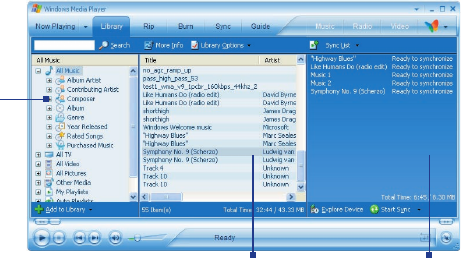
188 Experiencing Multimedia
• In the File List which is the middle pane, multi-select desired files
then drag them to the Sync List.
• Click the Start Sync button found at the bottom of the Sync List.
Playlist
File List Sync List
Note Audio files copy faster if the desktop Player is configured to automatically set
the quality level for audio files copied to your device. For more information,
see desktop Player Help on the PC.
Play media
To play items on your device
Use the library on Windows Media Player Mobile to find and play songs,
videos, and playlists that are stored on your device or removable storage
card.
1. If you are not on the Library screen, tap Menu > Library.
2. On the Library screen, tap the Library arrow (near the top of the
screen), then tap the media storage that you want use, for example,
Storage Card.
3. In most cases, Windows Media Player Mobile automatically updates
the library. However, you can manually update the library to ensure
Experiencing Multimedia 189
that it contains new files that you recently copied to your device or
storage card. Tap Menu > Update Library to manually update the
library list.
4. Select a category (for example, My Music or My Playlists).
5. Tap and hold the item that you want to play (such as a song, album, or
artist name), then tap Play.
Note To play a file that is stored on your device but is not in a library, on the Library
screen, tap Menu > Open File. Tap and hold the item that you want to play
(such as a file or a folder), then tap Play.
To play an item on a network
Use the Open URL command to play a song or video that is stored on the
Internet or on a network server.
1. If you are not on the Library screen, tap Menu > Library.
2. Tap Menu > Open URL.
3. Do one of the following:
• In the URL box, enter a network address.
• In the History box, tap a URL that you have previously used.
Note To play an item on a network, you must be connected to a network. For more
information about creating a remote connection between your device and a
network, see Connections Help on your device.
Use playlists
A playlist is a list of digital media files that play in a specified order. By using
playlists, you can group audio and video files together for convenient
playback.
In the desktop Player, you can create a playlist of media files and
synchronize the desktop Player with your device. For more information
about synchronizing media, see “Copy media files to your device” earlier in
this chapter.
In Windows Media Player Mobile on your device, your playlists are available
in the Library under the My Playlists category. There is also a temporary
playlist, called Now Playing, which lists the currently playing file, as well

190 Experiencing Multimedia
as any files that have been queued up to play next. You can create a new
playlist on your device by saving the current Now Playing playlist and by
giving it a new name.
To save a new playlist
1. If you are not on the Library screen, tap Menu > Library.
2. Tap to select a category (for example, My Music or My Playlists).
3. Select a media file that you want, then tap Menu > Queue Up. This
adds the file to the Now Playing list.
Repeat this step until you have added all desired media files to the
Now Playing list.
Note You cannot select multiple files simultaneously.
4. After adding the media files, tap Menu > Now Playing.
5. On the Now Playing screen, tap Menu > Save Playlist.
6. Enter the playlist name then tap Done.
7. To play back the playlist you created, tap My Playlists in the Library,
select your playlist, then tap Play.
Troubleshooting
If you encounter a problem while using the Windows Media Player Mobile, a
number of resources are available to help you troubleshoot the issue.
For more information, see the Troubleshooting Windows Media Player
Mobile page at the Microsoft Web site (http://www.microsoft.com/
windows/windowsmedia/player/windowsmobile/troubleshooting.aspx).

Chapter 12
Managing Your Pocket PC Phone
12.1 Adding and Removing Programs
12.2 Copying Files
12.3 Managing Memory
12.4 Resetting Your Pocket PC Phone
12.5 Checking System Information
12.6 Battery Saving Tips
192 Managing Your Pocket PC Phone
12.1 Adding and Removing Programs
Before you purchase additional programs for your device, you should note
the model name of your device, the version of Windows Mobile software
running on it, and the type of processor. This information will help you
select a program that is compatible with your device. For more information,
see “To get detailed device information” and “To find the operating system
version number” in this chapter.
Programs available for purchase usually include a Setup program
(commonly named "setup.exe") that you must first run on your PC. You can
then use ActiveSync to add programs to your device, or add a program
directly from the Internet.
To add programs
1. Download the program to your PC (or insert the CD or disk that
contains the program into your PC). You may see a single *.exe file,
a *.zip file, a Setup.exe file, or several versions of files for different
device types and processors. Be sure to select a program designed for
your device and processor type.
2. Read any installation instructions or documentation that comes with
the program. Many programs provide special installation instructions.
3. Connect your device to the PC.
4. Double-click the *.exe file.
• If the executable file is an installation wizard, follow the
instructions on the screen. The wizard will automatically install the
program to your device.
• If an installation wizard does not start, you will see an error
message stating that the program is valid but that it is designed
for a different type of computer. You will need to copy this
program directly to your device. If you cannot find any installation
instructions for the program, use ActiveSync to copy the program
file to the Program Files folder on your device.
Managing Your Pocket PC Phone 193
To remove programs
You can only remove programs that you installed. Programs that come with
your device cannot be removed.
1. Tap Start > Settings > System tab > Remove Programs.
2. In the Programs in storage memory list, select the program you
want to remove, and tap Remove.
3. Tap Yes. If another confirmation message appears, tap Yes again.
12.2 Copying Files
You can copy files to your PC using ActiveSync, or copy files to a storage
card you insert into your device. Your device has an expansion slot for
inserting a microSD card.
Using ActiveSync, you can copy or move information from the PC to your
device and vice versa. Copying a file results in separate versions of a file on
your device and PC. Because the files are not synchronized, changes made
to one file will not affect the other.
Note If you want to automatically update information on both your device and PC,
synchronize the information instead. For more information about copying
and synchronizing files, see ActiveSync Help on your PC.
To copy files to a storage card
1. Make sure the storage card is properly inserted into your device.
2. Tap Start > Programs > File Explorer and navigate to the
appropriate folder.
3. Tap and hold the file you want to copy, and tap Copy.
4. Tap the folder list (labeled My Documents by default) and tap
Storage Card.
5. Tap Menu > Edit > Paste.
To copy a file between your device and the PC
1. Connect your device to the PC.
2. In ActiveSync, click Explore, which opens the Mobile Device folder of
your device.
3. To copy a file from your device to your PC:

194 Managing Your Pocket PC Phone
a. In the Mobile Device folder, go to the file that you want to copy.
b. Right-click the file, then click Copy.
c. Locate the destination folder on your PC. Right-click the folder,
then click Paste.
4. To copy a file from your PC to your device:
a. On your PC, navigate to the folder that contains the file you want
to copy.
b. Right-click the file, then click Copy.
c. Right-click the destination folder under Mobile Device, then click
Paste.
To automatically save files on a storage card
In the Word Mobile, Excel Mobile, and Notes programs, you may find it
helpful to save all new documents, notes, and workbooks directly on a
storage card.
1. From the program file list, tap Menu > Options.
2. With a storage card inserted in your device, in the Save to box, select
the appropriate storage card to automatically save new files on the
storage card.
3. Tap OK.
Note In the file or note list, a storage card symbol ( ) is displayed next to the
names of files saved on a storage card.
Managing Your Pocket PC Phone 195
12.3 Managing Memory
You may need to stop a program if it becomes unstable or the program
memory is low.
To see how much memory is available
• Tap Start > Settings > System tab > Memory.
• On the Main tab, the amount of memory allocated to file and data
storage versus program storage is displayed, as well as the amount of
memory in use versus the available memory.
To see available storage card memory
You can see how much memory is available on a storage card that is
inserted in your device.
1. Tap Start > Settings > System tab > Memory.
2. Tap the Storage Card tab.
To free up program memory
Try the following to free memory on your device:
• Close programs you are not currently using.
• Move e-mail attachments to a storage card.
• Move files to a storage card. Tap Start > Programs > File Explorer.
Tap and hold the file, and tap Cut. Browse to the storage card folder
and tap Menu > Edit > Paste.
• Delete unnecessary files. Tap Start > Programs > File Explorer. Tap
and hold the file, and tap Delete.
• Delete large files. To find your largest files, tap Start > Programs >
Search. In the Type list, tap Larger than 64 KB, and tap Search.
•
In Internet Explorer Mobile, delete temporary Internet files and clear
history information. For more information, see “Internet Explorer
Mobile” in Chapter 6.
• Remove programs you no longer use.
• Reset your device.
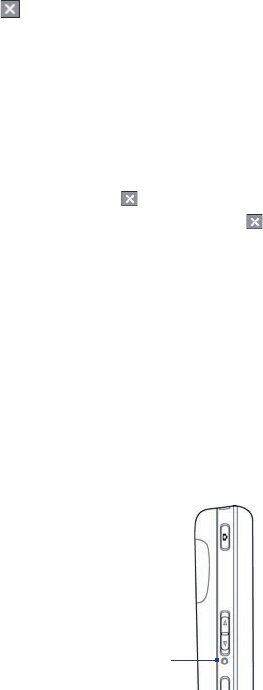
196 Managing Your Pocket PC Phone
To close a program
Tapping the button in a program may just close the program screen.
In this case, the program continues to run in the background. You can end
running programs manually by following these steps:
1. Tap Start > Settings > System tab > Memory > Running Programs
tab.
2. In the Running Programs List, tap the program you want to close,
and tap Stop.
Tips •
In most programs, you can also use the on-screen keyboard shortcut
Ctl+q to shut down the program.
• You can configure the button to directly shut down running programs.
For more information, see “To configure the button using Task
Manager".
12.4 Resetting Your Pocket PC Phone
Occasionally, you may need to reset your device. A soft (or normal) reset
of your device clears all active program memory and shuts down all
active programs. This can be useful when your device is running slower
than normal, or a program is not performing properly. A soft reset is
also necessary after the installation of some programs. If a soft reset is
performed when programs are running, unsaved work will be lost.
To perform a soft reset
• Use the stylus to press the RESET button found on the middle left side
of your device. Your device restarts and displays the Today screen.
RESET button

Managing Your Pocket PC Phone 197
You can also perform a hard reset (also known as a full reset). A hard
reset should be performed only if a normal reset does not solve a system
problem. After a hard reset, the device is restored to its default settings - the
way it was when you first purchased it and turned it on. Any programs you
installed, data you entered, and settings you customized on your device will
be lost. Only Windows Mobile software and other pre-installed programs
will remain.
To perform a hard reset
1. Press and hold the left SOFT KEY and the right SOFT KEY, and at the
same time, use the stylus to press the RESET button at the middle left
side of your device.
2. Release the stylus, but continue pressing the two SOFT KEYs until you
see the following message on the screen:
This operation will delete
all your personal data,
and reset all settings
to manufacturer default.
Press Send to restore
manufacturer default, or
press other keys to cancel.
3. Release the two SOFT KEYs, and then press the button on your
device.
Warning! Your device will be set back to factory default settings. Please ensure any
additional installed programs and/or user data have been backed up before
a hard reset is performed.

198 Managing Your Pocket PC Phone
12.5 Checking System Information
If you want to find out about technical details about your device such as
the type or speed of the processor, memory size, etc., you can check under
Settings for device information.
To find the operating system version number
• Tap Start > Settings > System tab > About.
The version of the operating system on your device is shown near the top of
the About screen.
To get detailed device information
• Tap Start > Settings > System tab > About.
The Version tab displays important device information, including the type
of processor and the amount of memory that is installed.
12.6 Battery Saving Tips
How long your battery power lasts depends on battery type and how you
use your device. Try the following to help preserve battery life:
• When the device is not in use, press POWER to switch off the display.
• Tap the battery icon ( ) on the Today screen. On the Advanced
tab of the Power settings screen, you can specify when your device
automatically turns off the display to conserve battery power. For
optimum conservation, specify 3 minutes or less.
• Use the AC adapter to plug your device into external power whenever
possible, especially when using a microSD card or when using a
modem or other peripherals.
• Adjust the backlight settings. For more information, see “To set the
backlight to dim after a time delay” in Chapter 4.
• When you know you are out of range of your Wi-Fi networks, turn
Wi-Fi off. Searching for networks consumes a lot of power. For more
information, see “Using Wi-Fi” in Chapter 8.
• Turn Bluetooth off when you are not using it.
Managing Your Pocket PC Phone 199
• Make the device visible to other devices only when you are trying to
establish a Bluetooth partnership. For more information, see “Using
Bluetooth” in Chapter 8.
• Enable your device to receive incoming beams setting only while
you are trying to receive beamed files. To find this setting, tap Start >
Settings > Connections > Beam.
• Lower the volume.
• Close battery-intensive programs, such as the Camera, when you are
done using them. Make sure the programs are ended and are not
continuously running in the background. For more information about
ending running programs, see “To close a program” in this chapter.
200 Managing Your Pocket PC Phone

13.1 Word Mobile
13.2 Excel Mobile
13.3 Viewing Slide Shows with PowerPoint
Mobile
13.4 Using Adobe Reader LE
13.5 Using Java
13.6 Using ZIP
13.7 Using Voice Command or Voice Dial ??
Chapter 13
Using Other Applications
202 Using Other Applications
13.1 Word Mobile
Word Mobile is a streamlined version of Microsoft Word. Word documents
created on your PC can be opened and edited on your device. You can also
create and edit documents and templates in Word Mobile and save them as
*.doc, *.rtf, *.txt, and *.dot files.
You can have only one document open at a time. When you open a second
document, the first one is saved and closed automatically.
To create a Word file
1. Tap Start > Office Mobile > Word Mobile.
2. In Word Mobile, tap New. You will see either a blank document or
template, depending on what you have selected as the default
template.
3. Enter text as desired.
4. Tap Menu, then choose whether to set the font, paragraph alignment
and indentation, insert the date, do a spelling check, and more.
5. When finished, tap OK to save and close the file.
When you close a newly created document, it is automatically named
after the first several words in the document and placed in the Word
Mobile document list. You can easily rename the document with a more
meaningful name and move it to another folder or a storage card.
Note Word Mobile does not fully support some features of Microsoft Word such as
revision marks and password protection. Some data and formatting may be
lost when you save the document on your device. To see a complete list of
features that are not supported in Word Mobile, see Help on your device.
Using Other Applications 203
13.2 Excel Mobile
Excel Mobile makes it easy for you to open and edit Excel workbooks and
templates created on your PC. You can also create new workbooks and
templates on your device.
To create an Excel file
1. Tap Start > Office Mobile > Excel Mobile.
2. In Excel Mobile, tap New. You’ll see either a blank worksheet or
template, depending on what you’ve selected as the default template.
3. Tap a cell to select it. Using the on-screen keyboard, enter your data
then tap the Enter key.
4. Tap Menu, then choose whether to insert cells, charts, symbols or
functions, format rows and columns, and more.
5. When finished, tap OK to save and close the file.
Tips • Work in full-screen mode to see as much of your workbook as possible.
• Tap View > Zoom and select a percentage so that you can easily read the
worksheet.
Note Excel Mobile does not fully support some features such as formulas and
cell comments. Some data and formatting may be lost when you save the
workbook on your device. To see a complete list of features that are not
supported in Word Excel, see Help on your device.

204 Using Other Applications
13.3 Viewing Slide Shows with PowerPoint Mobile
With PowerPoint Mobile, you can open and view slide show presentations
created on your PC. Slide shows in *.ppt and *.pps format created using
PowerPoint '97 and later can be viewed in PowerPoint Mobile.
Many presentation elements built into the slide shows such as slide
transitions and animations will play back on the device. If the presentation
is set up as a timed slide show, one slide will advance to the next
automatically. Links to URLs are also supported.
Features not supported in PowerPoint Mobile include:
• Notes. Notes written for slides will not be visible.
• Rearranging or editing slides. PowerPoint Mobile is a viewer only.
• Some file formats. Files created in *.ppt format earlier than
PowerPoint '97 and HTML files in *.htm and *.mht formats are not
supported.
To start a slide show presentation
1. Tap Start > Office Mobile > PowerPoint Mobile.
2. In the presentation list, tap the slide show you want to view.
3. Tap the current slide to advance to the next slide.
4. To navigate between slides, tap > Next or Previous, or tap Go to
Slide and tap the slide you want to view.
If the presentation is set up as a timed slide show, slides will advance
automatically.
Notes • If you have zoomed in to see a slide in more detail, you cannot navigate to
another slide until you zoom out.
•
Tapping Next or Previous may play an animation on a slide rather than
navigate to another slide.
To stop a slide show
• In a PowerPoint Mobile presentation, tap > End Show.
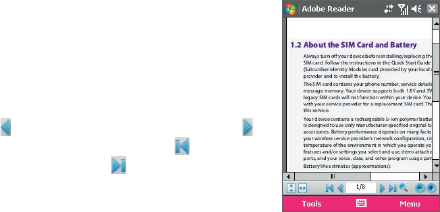
Using Other Applications 205
13.4 Using Adobe Reader LE
Adobe Reader LE is an application for viewing PDF (Portable Document
Format) documents on your device. It supports a subset of the features
found in the PC versions of Adobe Reader.
To open a PDF file on your device
Do one of the following:
• Tap Start > Programs > Adobe Reader LE. Browse the folders on
your device or storage card and find the desired PDF file. Tap the file
to open it.
• Open File Explorer and find the desired PDF file, then double-tap the
file to open it.
To navigate through a PDF document
When you are viewing a PDF document, you can do any of the following:
• Use the vertical and horizontal scroll bars
(including the Up, Down, Right and Left
arrow keys on the bars) to move to the
desired direction of the page.
• Press NAVIGATION up/down/right/left to
move to the desired direction of the page.
• Tap to move to the previous page; tap
to move to the next page. Tap to jump
to the first page; tap to jump to the last
page.
• Tap Tools > Go To to select the desired
page to view.
To adjust the display size
Tap Tools > Zoom, then select one of the following options:
• Select In/Out to enlarge/reduce the display size; or
• Select To % to specify a zoom ratio using a slider (from 8% to 1000%);
or
• Select Fit Screen to display the entire page in the window, or select
Fit Width to make the page width fit in the width of the window.

206 Using Other Applications
Tips Alternatively, you can also tap the following toolbar buttons at the bottom of
the screen:
• Tap to Fit Screen; tap to Fit Width.
•
Tap to zoom in; tap to zoom out.
To rotate the view
• Tap Tools > View > Rotate Right to rotate the document view
clockwise in 90 degree increments.
• Tap Tools > View > Rotate Left to rotate the document view
counterclockwise in 90 degree increments.
To change the page layout
• Tap Tools > View > Single Page to display one page at a time in the
document pane.
• Tap Tools > View > Continuous to display the pages in a continuous
vertical column.
To search for text in the document
1. Tap Tools > Find > Text or tap on the toolbar.
2. Type in the text to be searched, then tap Find.
3. The matched text in the document will be highlighted.
4. To search for the next occurrence of the text, tap Tools > Find > Next.
To exit Adobe Reader LE
• Tap Menu > Exit.
Tips • Adobe Reader LE displays a bookmark pane for the PDF files that contain
bookmarks. Tap the bookmarks to go to a specific section/page within the
file.
• Adobe Reader LE supports password-protected PDF files with up to 128-
bit encryption. When you open a password-protected PDF file, you will be
prompted to enter the password before the file can be opened.
Using Other Applications 207
13.5 Using Java
MIDlets are Java applications such as games and tools that can run on
mobile devices, while a MIDlet suite is a collection of one or more MIDlets.
The Java program lets you download, install and manage MIDlets or MIDlet
suites on your device. Your device supports Java 2 Micro Edition, J2ME.
To open the Java program
Tap Start > Programs > Java.
Install and launch MIDlets/MIDlet suites
There are several ways to install a MIDlet/MIDlet suite.
To download and install from a URL address
1. On the Java screen, tap Menu > Install > URL.
2. Tap Menu > Add.
3. Enter a descriptive name for the web page.
4. Enter the URL address from where to download. The web page must
contain links to .jad or .jar files.
5. Tap OK. The name of the web page you specified will then be listed
on the screen.
6. Tap the name of the web page, or tap Go.
7. The program will then retrieve the links and display the file names of
MIDlets/MIDlet suites. Select a file name then tap Install.
To download and install via Internet Explorer Mobile
1. On the Java screen, tap Menu > Install > Browser to open Internet
Explorer Mobile.
2. Locate the MIDlet/MIDlet suite while connected to the Internet.
3. Select the MIDlet/MIDlet suite to download.
4. Information about the MIDlet/MIDlet suite is then displayed. Tap
Continue.
5. Confirm to start downloading.
6. Select <root> or a folder where to install the MIDlet suite to, then tap
OK.
208 Using Other Applications
To install from your device
You can copy MIDlets/MIDlet suites from the PC to your device using the
USB sync cable, infrared, or Bluetooth connection. Copy them to the root
folder or any subfolder on your device.
1. On the Java screen, tap Menu > Install > Local Files. The program
then searches for MIDlets/MIDlet suites on your device and displays
them in a list.
2. From the list, tap the MIDlet/MIDlet suite that you want to install.
3. Confirm to start the installation.
4. Select <root> or a folder where to install the MIDlet suite to, then tap
OK.
To run a MIDlet/MIDlet suite
Do one of the following:
• After installation of the MIDlet/MIDlet suite is complete, tap Yes.
• On the Java screen, open the folder that contains the MIDlet/MIDlet
suite. Select the MIDlet/MIDlet suite then tap Launch.
To stop running a MIDlet/MIDlet suite
Tap Exit or Quit if presented on the MIDlet/MIDlet suite’s screen or menu.
Manage MIDlets/MIDlet suites
You can organize MIDlets/MIDlet suites into folders for easy identification,
move them from one folder to another, rename or update them, and more.
If the device memory is full, uninstall some MIDlets/MIDlet suites to free up
memory space.
To create folders
1. Tap Menu > New Folder.
2. Enter a folder name then tap Create.
Using Other Applications 209
To move a MIDlet to another folder
1. Tap and hold a MIDlet/MIDlet suite then tap Move. Alternatively, you
can tap Menu > Actions > Move.
2. Tap the destination folder.
To rename a MIDlet or folder
1. Tap and hold a MIDlet/MIDlet suite then tap Rename. Alternatively,
you can tap Menu > Actions > Rename.
2. Enter a new name, then tap Save.
To update a MIDlet/MIDlet suite
Tap and hold a MIDlet/MIDlet suite then tap Update. Alternatively, you can
tap Menu > Actions > Update.
Java will search for updates for the selected MIDlet/MIDlet suite where it
was installed from before.
To view information about a MIDlet/MIDlet suite
• Tap Menu > Actions > Info.
• If the MIDlet/MIDlet suite is protected by DRM (Digital Rights
Management), tap Menu > Actions > Protection to view status and
usage rights.
To uninstall MIDlets
Before you uninstall a MIDlet, make sure that it is not running.
1. Tap and hold the MIDlet, and tap Uninstall.
2. Tap OK to confirm.
Note To uninstall all MIDlets and folders from the current folder, tap Menu >
Uninstall All.
To set MIDlet permission settings
For each MIDlet already installed, Java allows you to individually set
permission options to perform certain actions. A MIDlet can be enabled to
perform these actions:

210 Using Other Applications
Action Description
Local connection Enables a MIDlet to access device connections such as via
Bluetooth.
Location
information access
Determines whether a MIDlet can access location related
information.
Recording Enables a MIDlet to record audio and images.
Messaging Enables a MIDlet to send and/or receive SMS/MMS. This
uses airtime and may incur costs.
Net access Enables a MIDlet to access the Internet. This uses airtime
and may incur costs.
Auto start Enables a MIDlet to be started automatically to handle an
incoming event. If there is another MIDlet running, it may
be interrupted.
Read user data Allows a MIDlet to read data on the device memory or
storage card.
Note Some actions may not be available for certain MIDlets.
You can set permission options for performing each action by following
these steps:
1. Tap and hold a MIDlet then tap Security. Alternatively, you can tap
Menu > Actions > Security.
2. For each action, choose one of the following permission options:
• Always. Enables a MIDlet to perform the action.
• Never. Prohibits a MIDlet to perform the action.
• Prompt. Asks for your confirmation whenever a MIDlet attempts
to perform the action.
3. Tap Save.
Note Changes to permission settings for a MIDlet in a multi-MIDlet suite will affect
the settings for the whole suite.
Using Other Applications 211
13.6 Using ZIP
This feature allows you to save memory and increase the storage capacity
of your device by compressing files in the conventional ZIP format. You can
view and extract archive files received from various sources. You can also
create new *.zip files on your device.
Start ZIP and Open .zip files
You can use ZIP to either archive files or open an existing archive file on
your device. Each time you start ZIP on your device, it searches for files
that have the .zip file extension, and displays these files on the Archive List
screen.
To start ZIP on your device
• Tap Start > Programs > ZIP.
To open a ZIP file and extract files
1. Open a file using any of the following:
• Select a file and tap File > Open Archive.
• Tap and hold a file and tap Open Archive.
• Double-tap a file.
Note You cannot select multiple ZIP files.
2. The files contained in the zip file are then displayed. Select files by
doing one of the following:
• Tap to select a file.
• To select several files, tap Action and make sure Multi-Select
Mode is selected. Select files by tapping each file. (Tap a selected
file to deselect it).
• To select all files, tap Action > Select All.
3. Tap Action > Extract.
4. Choose a folder in which files will be extracted to, then tap Extract.
212 Using Other Applications
To create a zip archive
1. Tap File > New Archive.
2. On the Save As screen, enter a zip file name and choose a folder in
which to save the zip file. You can also choose whether the zip file will
be saved on the device’s main memory or a storage card.
3. Tap Save.
4. Tap Action > Add.
5. Double-tap the folder that contains the files you want to archive.
6. Select files by doing one of the following:
• Tap to select a file.
• To select several files, tap and hold on the screen, then select
Multi-Select Mode. Select files by tapping each file. (Tap a
selected file to deselect it).
• To select all files, tap and hold on the screen, then tap Select All.
7. Tap Add.
8. Tap File > Close Archive.
9. After closing the zip file, you can tap File > Find Archive to search for
all zip files and display them on the Archive List screen.
Using Other Applications 213
13.7 Using Voice Command or Voice Dial ??
214 Using Other Applications
Appendix
A.1 Regulatory Notices
A.2 PC Requirement to Run ActiveSync 4.5
A.3 Specifications
216 Appendix
A.1 Regulatory Notices
Agency identification numbers
For regulatory identification purposes, your product (Pocket PC Phone) is
assigned a model number of HERA110. The Battery Pack has been assigned
a model number of HERA160.
To ensure continued reliable and safe operation of your device, use only the
accessories listed in this document.
Note This product is intended to be used with a certified class 2 limited power
source, rated 5 volts DC, maximum 1A power supply unit.
Federal Communications Commission Notice
This device complies with part 15 of the FCC Rules. Operation is subject
to the following two conditions: (1) This device may not cause harmful
interference, and (2) this device must accept any interference received,
including interference that may cause undesired operation.
This equipment has been tested and found to comply with the limits for a
Class B digital device, pursuant to Part 15 of the FCC Rules. These limits are
designed to provide reasonable protection against harmful interference in
a residential installation. This equipment generates, uses, and can radiate
radio frequency energy and, if not installed and used in accordance with
the instructions, may cause harmful interference to radio communications.
However, there is no guarantee that interference will not occur in a
particular installation. If this equipment does cause harmful interference to
radio or TV reception, which can be determined by turning the equipment
on and off, the user is encouraged to try to correct the interference by one
or more of the following measures:
• Reorient or relocate the receiving antenna.
• Increase the separation between the equipment and receiver.
• Connect the equipment into an outlet on a circuit different from that
to which the receiver is connected.
• Consult the dealer or an experienced radio or television technician for
help.
Appendix 217
• The FCC requires the user to be notified that any changes or
modifications made to the device that are not expressly approved
by High Tech Computer Corporation may void the user’s authority to
operate the equipment.
Important safety information
Retain and follow all product safety and operating instructions. Observe all
warnings on the product and in the operating instructions.
To reduce the risk of bodily injury, electric shock, fire, and damage to the
equipment, observe the following precautions.
Safety precautions for RF exposure
Use only original manufacturer-approved accessories, or accessories that do
not contain any metal.
Use of non-original manufacturer-approved accessories may violate your
local RF exposure guidelines and should be avoided.
Heed service markings
Except as explained elsewhere in the Operating or Service documentation,
do not service any product yourself. Service needed on components inside
these compartments should be done by an authorized service technician or
provider.
Damage requiring service
Unplug the product from the electrical outlet and refer servicing to an
authorized service technician or provider under the following conditions:
• Liquid has been spilled or an object has fallen into the product.
• The product has been exposed to rain or water.
• The product has been dropped or damaged.
• There are noticeable signs of overheating.
• The product does not operate normally when you follow the
operating instructions.
Avoid hot areas
The product should be placed away from heat sources such as radiators,
heat registers, stoves, or other products (including amplifiers) that produce
heat.
218 Appendix
Avoid wet areas
Never use the product in a wet location.
Avoid pushing objects into product
Never push objects of any kind into cabinet slots or other openings in the
product. Slots and openings are provided for ventilation. These openings
must not be blocked or covered.
Mounting accessories
Do not use the product on an unstable table, cart, stand, tripod, or bracket.
Any mounting of the product should follow the manufacturer’s instructions,
and should use a mounting accessory recommended by the manufacturer.
Do not place the product with an unstable base.
Use product with approved equipment
This product should be used only with personal computers and options
identified as suitable for use with your equipment.
Adjust the volume
Turn down the volume before using headphones or other audio devices.
Cleaning
Unplug the product from the wall outlet before cleaning. Do not use liquid
cleaners or aerosol cleaners. Use a slightly damp cloth for cleaning, but
NEVER use water to clean an LCD screen.
Safety precautions for power supply unit
Use the correct external power source
A product should be operated only from the type of power source indicated
on the electrical ratings label. If you are not sure of the type of power source
required, consult your authorized service provider or local power company.
For a product that operates from battery power or other sources, refer to
the operating instructions that are included with the product. Handle
battery packs carefully: This product contains a Lithium-Ion Polymer
battery. There is a risk of fire and burns if the battery pack is handled
improperly. Do not attempt to open or service the battery pack. Do not
disassemble, crush, puncture, short external contacts or circuits, dispose of
in fire or water, or expose a battery pack to temperatures higher than
140° F (60° C).
Appendix 219
Exposure to radio frequency (RF) signals
Your device contains a radio transmitter and receiver. The radiated output
power is far below the international radio frequency exposure limits. These
limits are part of comprehensive guidelines and establish permitted levels
of RF energy for the general population. The guidelines are based on the
safety standards previously set by international standards bodies:
• American National Standards Institute (ANSI) IEEE. C95.1-1992
• National Council on Radiation Protection and Measurement (NCRP).
Report 86. 1986
• International Commission on Non-Ionizing Radiation Protection
(ICNIRP) 1996
• Ministry of Health (Canada), Safety Code 6. The standards include a
substantial safety margin designed to assure the safety of all persons,
regardless of age and health.
The exposure standard for wireless mobile phones employs a unit of
measurement known as the Specific Absorption Rate, or SAR.
The standard incorporates a substantial margin of safety to give additional
protection for the public and to account for any variations in usage. As
with other mobile radio transmitting equipment, users are advised that for
satisfactory operation of the equipment and for the safety of personnel, it
is recommended that no part of the human body be allowed to come too
close to the antenna during operation of the equipment.
Your device has an internal antenna. Use only the supplied integral antenna.
Use of unauthorized or modified antennas may impair call quality and
damage the phone, causing loss of performance and SAR levels exceeding
the recommended limits as well as result in non-compliance with local
regulatory requirements in your country.
To assure optimal phone performance and ensure human exposure to RF
energy is within the guidelines set forth in the relevant standards; always
use your device only in its normal-use position. Do not touch or hold the
antenna area unnecessarily when placing or receiving a phone call. Contact
with the antenna area may impair call quality and cause your device to
operate at a higher power level than needed. Avoiding contact with the
antenna area when the phone is IN USE optimizes the antenna performance
and the battery life.
220 Appendix
SAR Information
SAR: 0.717 W/Kg @1g (FCC)
Telecommunications & Internet Association (TIA) safety
information
Pacemakers
The Health Industry Manufacturers Association recommends that a
minimum separation of six inches be maintained between a handheld
wireless phone and a pacemaker to avoid potential interference with the
pacemaker. These recommendations are consistent with the independent
research by and recommendations of Wireless Technology Research.
Persons with pacemakers:
• Should ALWAYS keep the phone more than six inches from their
pacemaker when the phone is turned ON.
• Should not carry the phone in a breast pocket.
• Should use the ear opposite the pacemaker to minimize the potential
for interference. If you have any reason to suspect that interference is
taking place, turn the phone OFF immediately.
Hearing Aids
Some digital wireless phones may interfere with some hearing aids. In the
event of such interference, you may want to consult your service provider,
or call the customer service line to discuss alternatives.
Other Medical Devices
If you use any other personal medical device, consult the manufacturer
of your device to determine if they are adequately shielded from external
RF energy. Your physician may be able to assist you in obtaining this
information.
Turn the phone OFF in health care facilities when any regulations posted in
these areas instruct you to do so. Hospitals or health care facilities may be
using equipment that could be sensitive to external RF energy.

Appendix 221
Other tips and cautions
• Avoid using the phone near metal structures (for example, the steel
frame of a building).
• Avoid using the phone near strong electromagnetic sources, such as
microwave ovens, sound speakers, TV and radio.
• Avoid using the phone after a dramatic change in temperature.
Safety Precautions
SAFETY IN AIRCRAFT: This product can cause interference to an aircraft’s
navigation system and network. In most countries it is against the law to
use this product on board an airplane.
ENVIRONMENTAL SAFETY: Do not use this product in gas stations, fuel
stores, chemical plants and locations containing explosives.
ROAD SAFETY: Vehicle drivers in motion are not permitted to use
handheld telephony services, except in emergency. In some countries,
using hands-free devices as an alternative is allowed.
MEDICAL EQUIPMENT SAFETY: This product may cause medical
equipment malfunction. In most hospitals or medical centers use of this
product is forbidden.
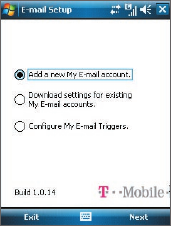
Exchanging Messages 107
T-Mobile’s Set Up My E-mail screen
Tips • If you select Download settings for existing My E-mail accounts,
you will be taken to a screen where you can download e-mail settings
from your existing account(s).
• If you select Configure My E-mail Triggers, you will be taken to a
screen where you can enable or disable e-mail updates. Follow the on-
screen instructions to learn more about updates.
3. Type your e-mail address and password.
4. Tap Next.
After you have added an e-mail account, you will see it on Windows
Mobile’s Account Picker screen. (See “The Account Picker screen” earlier in
this chapter.) You are now ready to send and receive messages with this
account.
If you have more e-mail accounts, perform the above procedure again to
add them to your device.
Notes • If you turn off the Alerts feature at www.my.t-mobile.com, you will not
receive automatic e-mail updates and My E-mail alerts on your device.
• If you want to access My E-mail on your computer, you will need to
register for an account on http://my.t-mobile.com.
Appendix 223
A.2 PC Requirement to Run ActiveSync 4.5
To connect your device to the PC, you must have Microsoft® ActiveSync®
program installed on your PC. ActiveSync 4.5 is included in the Getting
Started Disc, which is compatible with the following operating systems
and applications:
• Microsoft® Windows® 2000 Service Pack 4
• Microsoft® Windows Server® 2003 Service Pack 1
• Microsoft® Windows Server® 2003 IA64 Edition Service Pack 1
• Microsoft® Windows Server® 2003 x64 Edition Service Pack 1
• Microsoft® Windows® XP Professional Service Packs 1 and 2
• Microsoft® Windows® XP Home Service Packs 1 and 2
• Microsoft® Windows® XP Tablet PC Edition 2005
• Microsoft® Windows® XP Media Center Edition 2005
• Microsoft® Windows® XP Professional x64 Edition
• Microsoft® Outlook® 98, Microsoft® Outlook® 2000 and Microsoft®
Outlook® XP, and Microsoft® Outlook® 2003 messaging and
collaboration clients
• Microsoft® Office 97, excluding Outlook
• Microsoft® Office 2000
• Microsoft® Office XP
• Microsoft® Office 2003
• Microsoft® Internet Explorer® 4.01 or later (required)
• Microsoft® Systems Management Server 2.0

224 Appendix
A.3 Specifications
System Information
Processor TI's OMAPTM 850, 201 MHz
Memory - ROM : 128 MB
- RAM : 64 MB SDRAM
(Figures are the total ROM and RAM memory available
for use and storage. Since the memory is shared by the
Operating System, applications, and data, the actual
available memory is less than what is written).
Operating System Crossbow
Power
Battery Rechargeable Lithium-ion polymer battery, 1130 mAh
Charging Time Up to 4 hours
Battery Life
(estimates)
Standby time: Up to 150 - 200 hours for GSM
Talk time (Screen off ): Up to 3.5 - 5 hours for GSM
Media playback time: Up to 8 hours (WMV);
Up to 12 hours (WMA)
AC Adapter Voltage range/frequency: 100 - 240V AC, 50/60 Hz
DC output: 5V and 1A
Display
LCD Type 2.8” transflective TFT-LCD with backlight LEDs, touch-
sensitive screen
Resolution 240 x 320 with 65,536 colors
Alignment Portrait and Landscape
GSM / GPRS / EDGE Module
Functionality Quad-band (850, 900, 1800, and 1900)
Internal Antenna Yes
Physical
Dimensions 109 mm (L) x 59 mm (W) x 18 mm (T)
Weight 168g (with battery)

Appendix 225
Camera Module
Type 2 Megapixel color CMOS camera
Resolution Photo: 1600x1200 (UXGA), 1280x960 (SXGA), 640x480
(VGA), 320x240 (QVGA), 160x120 (QQVGA)
Video: 176x144 (QCIF), 128x96
Digital Zoom Up to 10X
Connections
I/O Port HTC ExtUSBTM : an 11-pin mini-USB and audio jack in one
(ExtUSB is a proprietary connection interface that is
trademarked by HTC).
Car Antenna
Connector
Yes
Wireless
Connections
Bluetooth 2.0, Wi-Fi (IEEE 802.11 b/g)
Controls and Lights
Buttons • 5-way NAVIGATION Control
• Three program buttons : Voice Speed Dial/Voice Record,
Camera and Comm Manager
• Two phone functions : TALK and END
• START button
• OK button
• Two SOFT KEYs
• POWER button
• RESET button
Hardware
Keyboard
QWERTY keyboard with two additional SOFT KEYs.
LEDs The left (bi-color) LED shows Green and Amber lights for
GSM/GPRS/EDGE standby, message, and network status as
well as for notification and battery charging status.
The right LED shows a blinking Blue light for Bluetooth
system notification of powered-up and ready to transmit
Bluetooth signal, and a blinking Green light for Wi-Fi
status. When both Bluetooth and Wi-Fi are enabled, their
lights blink alternately.

226 Appendix
Audio
Audio Controller AGC
Microphone/
Speaker
Built-in/Dual, Hands-free
Headphone AMR/AAC/WAV/WMA/MP3 codec
Expansion Slots
Card Slot microSD™ (SD 2.0 compatible)